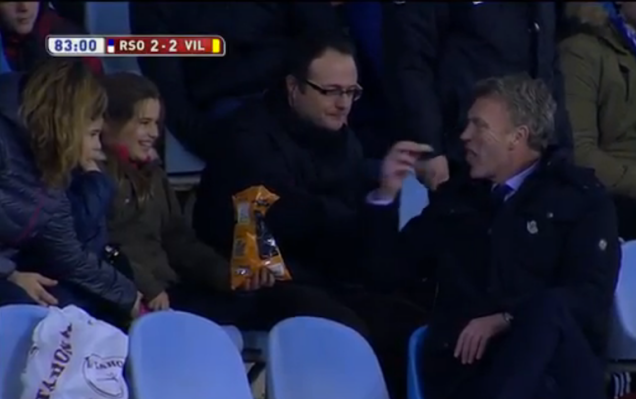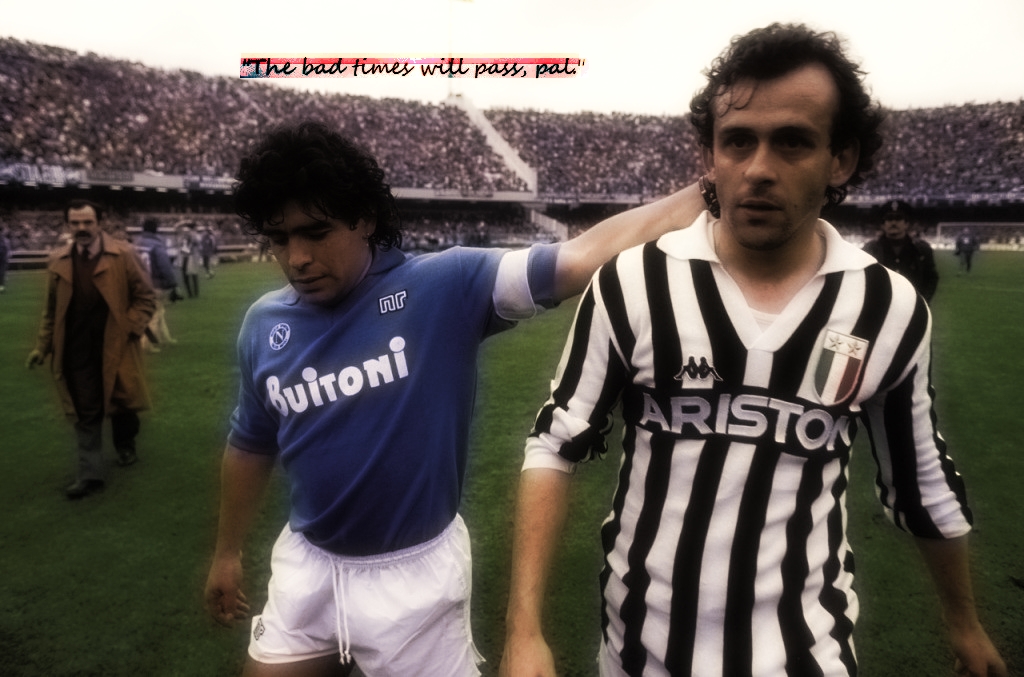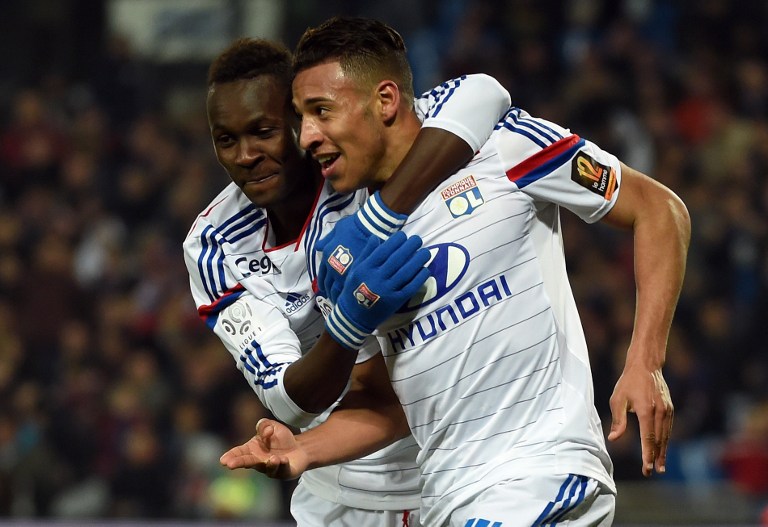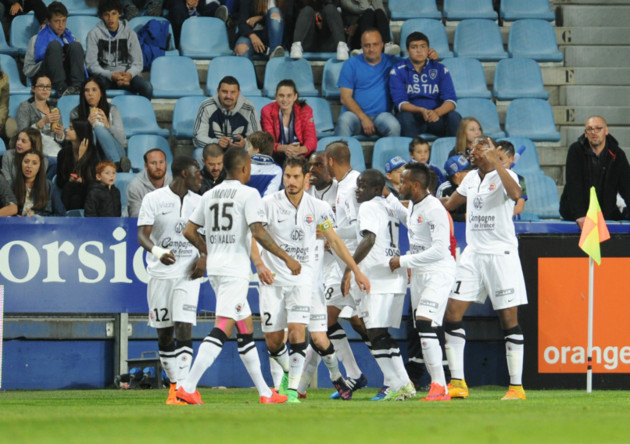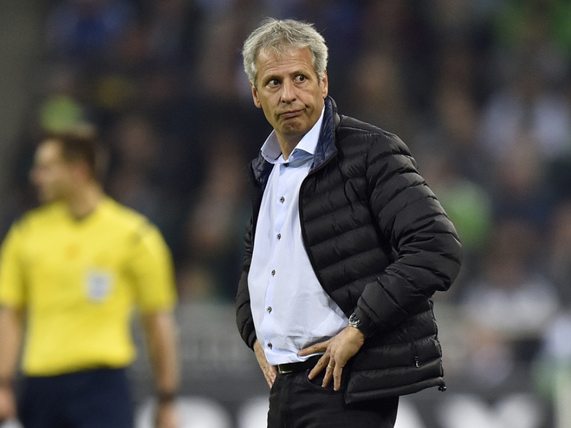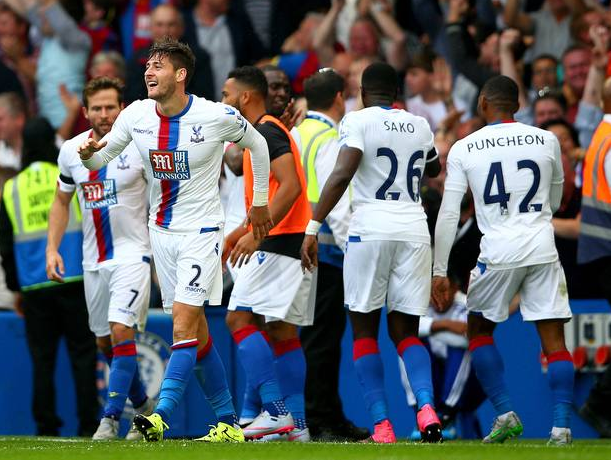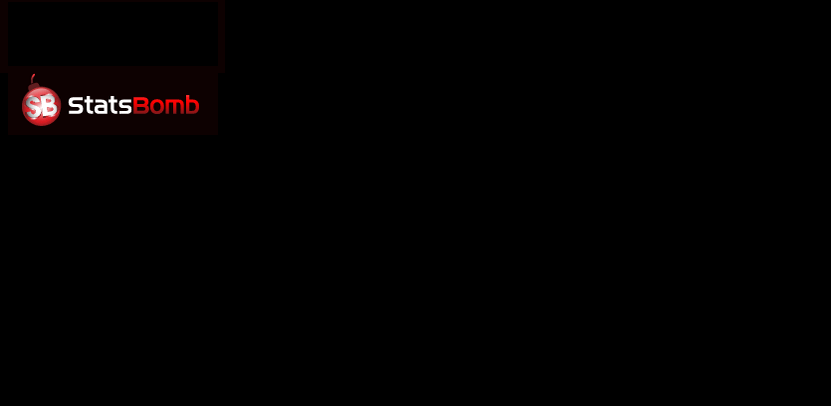We are six games into the season in Spain. Villarreal lead, Messi's out for two months, there's a logjam at the top, Sevilla just climbed off the bottom, and we finally have a day off without a league game. I think it's time to take a quick look at some of the early stats and stories. The inevitable: Death, Taxes(?), and the Two Title Contenders  It’s still the big two at the top. With 90% certainty we can say that one of Barcelona or Madrid will win the title, but the distribution within that 90% has shifted since the season has begun. The big story is obviously the Messi injury, which has played a big part in Madrid seeing their title odds increase 5% from match week 1. This has come despite Barcelona being a point ahead through a much tougher first six games. The bookies dropped Barcelona's odds in this weeks games around 10% after the injury. If we assume the bookies have it estimated right (and decades of evidence say that's usually a safe assumption), he costs them around .25-.3 points per match which means his injury could be a 2-point swing over just 6 matches. When Madrid and Barcelona have been separated by 3 total points over the past 82 league matches, that looms large. On the field with Messi, Barca's attack has looked a little different this season. Here are this years completions of 40+ yards that bring Barca into the Red Zone in front of goal:
It’s still the big two at the top. With 90% certainty we can say that one of Barcelona or Madrid will win the title, but the distribution within that 90% has shifted since the season has begun. The big story is obviously the Messi injury, which has played a big part in Madrid seeing their title odds increase 5% from match week 1. This has come despite Barcelona being a point ahead through a much tougher first six games. The bookies dropped Barcelona's odds in this weeks games around 10% after the injury. If we assume the bookies have it estimated right (and decades of evidence say that's usually a safe assumption), he costs them around .25-.3 points per match which means his injury could be a 2-point swing over just 6 matches. When Madrid and Barcelona have been separated by 3 total points over the past 82 league matches, that looms large. On the field with Messi, Barca's attack has looked a little different this season. Here are this years completions of 40+ yards that bring Barca into the Red Zone in front of goal: 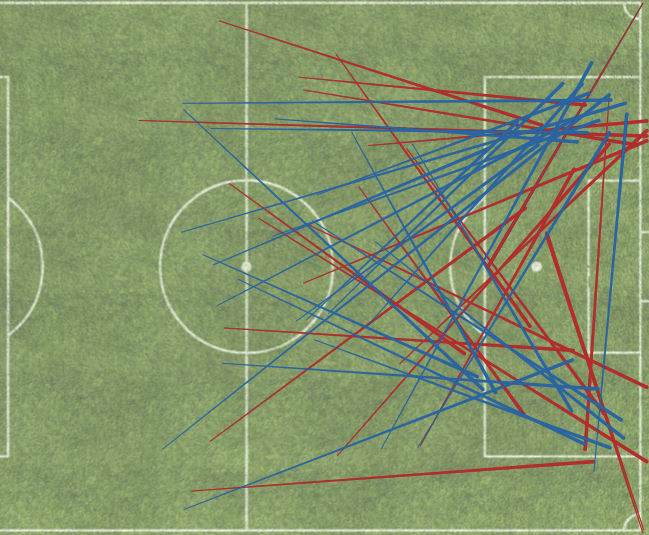 compared to last years against the same opponents (halved so the sample will be the same amount of minutes)
compared to last years against the same opponents (halved so the sample will be the same amount of minutes) 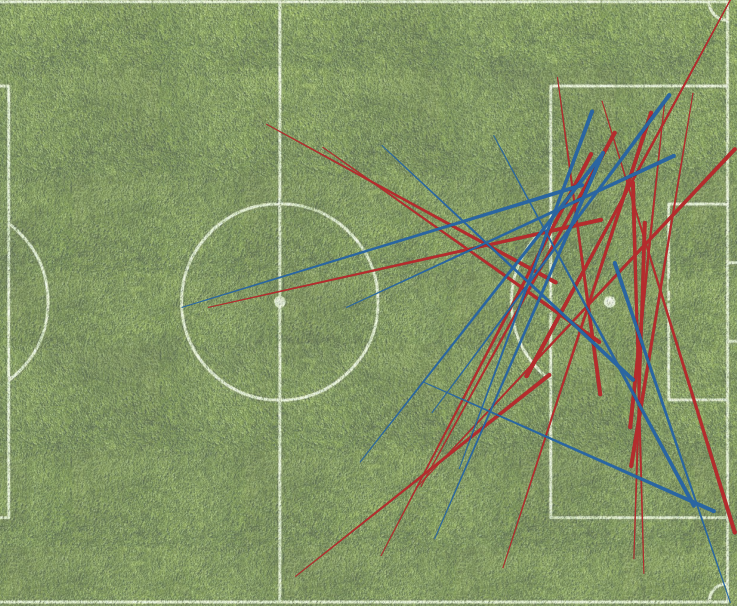 They have played nearly twice as many 40+ yarders into the Red Zone and yet strangely have seen their completion % on these bombs skyrocket from 24% to 48% this season. With this trend, their average completion distance in this area has risen from 15.9 yards (2.3 standard deviations lower than average) to basically league average distance this season. Rakitić and Mascherano are both 7-for-12 on these long passes, with Sergi Roberto and Luis Suárez on the receiving end of 7 and 6 respectively. What is the reason for this pretty large change in tactics and success rate? I don't know, it's quite baffling, but I think it could be helpful when they take on Leverkusen this week in one of those must-see matches. For Madrid, Messi’s injury is nice but more importantly they are simply playing better than last season. Last year Barcelona was way ahead of the pack in terms of dominating dangerous territory, this year Madrid have pulled even in that category. Last year Madrid completed a pass in the Red Zone in front of goal about 30 times per game, this year they are up above 35 with those being a bit higher quality this year as well (closer to goal or non-cross passes). They have had a schedule that has allowed them to ease into the season, but it’s still promising and comes in a category that tends to stabilize very quickly. Teams that show they can get the ball deep early in the season generally do so the rest of the season. Other stuff is important as well, but can be more variable which is why I like to focus on the basics so early.
They have played nearly twice as many 40+ yarders into the Red Zone and yet strangely have seen their completion % on these bombs skyrocket from 24% to 48% this season. With this trend, their average completion distance in this area has risen from 15.9 yards (2.3 standard deviations lower than average) to basically league average distance this season. Rakitić and Mascherano are both 7-for-12 on these long passes, with Sergi Roberto and Luis Suárez on the receiving end of 7 and 6 respectively. What is the reason for this pretty large change in tactics and success rate? I don't know, it's quite baffling, but I think it could be helpful when they take on Leverkusen this week in one of those must-see matches. For Madrid, Messi’s injury is nice but more importantly they are simply playing better than last season. Last year Barcelona was way ahead of the pack in terms of dominating dangerous territory, this year Madrid have pulled even in that category. Last year Madrid completed a pass in the Red Zone in front of goal about 30 times per game, this year they are up above 35 with those being a bit higher quality this year as well (closer to goal or non-cross passes). They have had a schedule that has allowed them to ease into the season, but it’s still promising and comes in a category that tends to stabilize very quickly. Teams that show they can get the ball deep early in the season generally do so the rest of the season. Other stuff is important as well, but can be more variable which is why I like to focus on the basics so early.  They are well ahead of the pack in SOTR and are hurling an incredible 23 shots per game at goal. There are at least signs that last years soft defense has been slightly toughened. It still shocks to look back and see no team in Spain allowed a higher completion % than Real Madrid in 14-15. No matter your tactics, that should never happen. This year they are in the middle of the pack, which I think is still a bit shameful for a team with that budget. As Mike Goodman showed in his great piece last week, Ronaldo is now a possession-finisher and not really a chance-creator for others. He has nearly totally eliminated the dribbling and ball-carrying part of his game, yet remains right at the top of the world. His 8.2 shots per game are more than Darmstadt or Bastia take as an entire team and very close to Bologna and Newcastle.
They are well ahead of the pack in SOTR and are hurling an incredible 23 shots per game at goal. There are at least signs that last years soft defense has been slightly toughened. It still shocks to look back and see no team in Spain allowed a higher completion % than Real Madrid in 14-15. No matter your tactics, that should never happen. This year they are in the middle of the pack, which I think is still a bit shameful for a team with that budget. As Mike Goodman showed in his great piece last week, Ronaldo is now a possession-finisher and not really a chance-creator for others. He has nearly totally eliminated the dribbling and ball-carrying part of his game, yet remains right at the top of the world. His 8.2 shots per game are more than Darmstadt or Bastia take as an entire team and very close to Bologna and Newcastle. 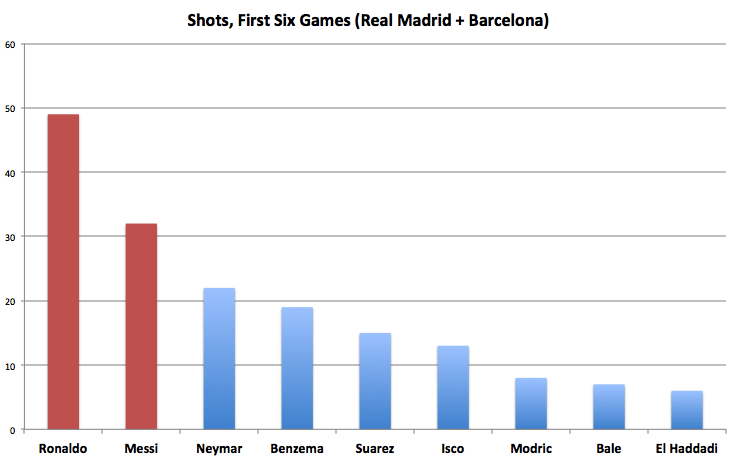
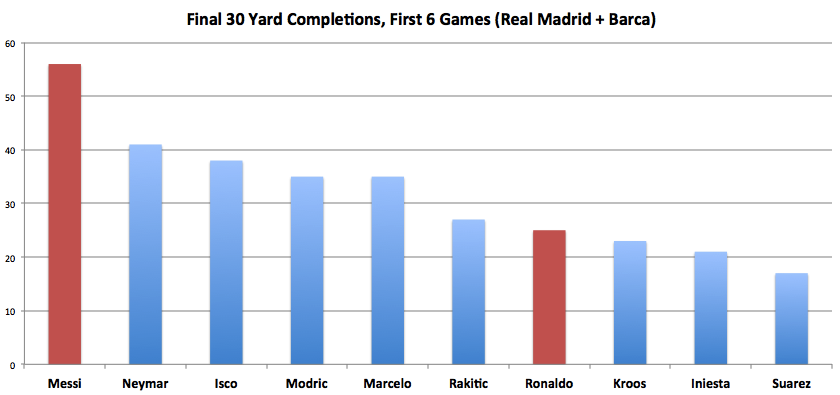 This shot map is simply too awesome not to share:
This shot map is simply too awesome not to share: 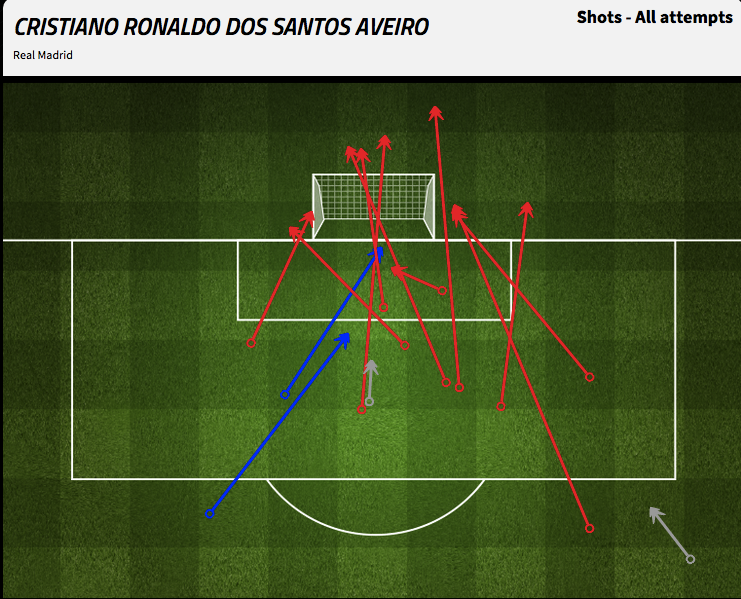 14 shots against Málaga from Ronaldo alone, from incredible positions as well. I'd love to see a list of players who have ever topped that in 90 minutes in a league game but can't find any way to get those numbers easily. Let me know if you have found a higher total. A different looking Atlético Madrid
14 shots against Málaga from Ronaldo alone, from incredible positions as well. I'd love to see a list of players who have ever topped that in 90 minutes in a league game but can't find any way to get those numbers easily. Let me know if you have found a higher total. A different looking Atlético Madrid  Much was made over their summer renovation up top and things look a bit different on the stat sheet in the early going. The defensive stats are all up pretty significantly from their simply stifling 2014-15 season. Offensively, they are shooting a bit more and popping up in front of goal more often but can’t quite get the big quality chance they have been so good at. The previous two years they have gotten 24% of their shots from inside 10 yards (easily best in the league each season, set pieces?) while this year they have just gotten 11 shots inside 10 yards, 14% of their total which is slightly below league average. It’s been just 6 games and it’s a team that seems to be switching how they play so there was always going to be transition time but we can say the transition hasn’t been successful quite yet. Moyes and the hot seat
Much was made over their summer renovation up top and things look a bit different on the stat sheet in the early going. The defensive stats are all up pretty significantly from their simply stifling 2014-15 season. Offensively, they are shooting a bit more and popping up in front of goal more often but can’t quite get the big quality chance they have been so good at. The previous two years they have gotten 24% of their shots from inside 10 yards (easily best in the league each season, set pieces?) while this year they have just gotten 11 shots inside 10 yards, 14% of their total which is slightly below league average. It’s been just 6 games and it’s a team that seems to be switching how they play so there was always going to be transition time but we can say the transition hasn’t been successful quite yet. Moyes and the hot seat 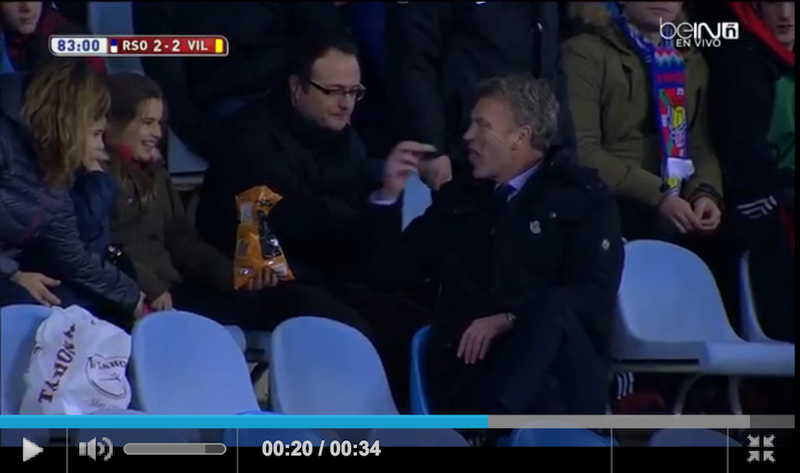 On the excellent Spanish Football Podcast, both Sid Lowe and Phil Kitromilides thought Moyes might be the first manager sacked if Real Sociedad don’t turn it around. This surprised me a little bit because they have been one of the best defensive teams in the early going in terms of raw numbers. No team limits their opposition Red Zone completions more than Real Sociedad have. However, when you look at the schedule you can see why the Sociedad fans could be getting restless. If they had just held each opponent (Sporting Gijón, Real Betis, Espanyol, Deportivo, Athletic, and Granada) to their season average they would still be 3rd-best. Knowing this their defensive accomplishment becomes much less impressive. Their offense is similar to last season in its mediocrity. It's again a little below average in terms of getting the ball deep, though at least they have picked up their league-worst rate of getting sub-10 yard shots. Last year a horrific 9% of their shots came from in close, this year it's in the land of respectability. A soft schedule has given Moyes passable underlying numbers, but a strong European contender would probably have done more. Malaga, Levante, and Las Palmas are coming soon as the easy start continues. Whether Moyes will last these next five games is still up in the air. Celta Vigo They remain one of the most watchable teams in Europe and are playing like one of the best teams in Spain right now. A 4-1 dismantling of Barcelona gave them a chance to go top before a disappointingly poor performance against Eibar kept them from reaching 1st place. They press high (only Barcelona are near their numbers), pass well, pop up in the Red Zone often and have a great shot on target rate (only Barca and Real Madrid are ahead in these last three categories). The reason a top 4 finish is still significantly under 50% in the betting markets is the defense can be cut open and exposed (one of easier teams to get in on goal against and allow one of highest completion % back there). They play in a way that provides great enjoyment to most neutrals so personally I will be cheering for them. Their manager Eduardo Berizzo is a Bielsa disciple who was recently described as "Bielsa without the madness" by Tim Vickery. Hopefully his team can avoid the late-season falloff Bielsa teams tend to experience. Other notes Sevilla have already taken 28 shots inside 10 yards, 5 more than the second place team in that category. They are fine despite a low point total…Levante are truly awful. They went an entire game against Las Palmas without completing a pass within 30 yards of the opposition goal. They get the ball into that Red Zone area only 37% as often as the average team and only Sporting Gijón allow opponents to spend more time in the Red Zone. Levante are very strong candidates for relegation (as probably are Sporting Gijón).
On the excellent Spanish Football Podcast, both Sid Lowe and Phil Kitromilides thought Moyes might be the first manager sacked if Real Sociedad don’t turn it around. This surprised me a little bit because they have been one of the best defensive teams in the early going in terms of raw numbers. No team limits their opposition Red Zone completions more than Real Sociedad have. However, when you look at the schedule you can see why the Sociedad fans could be getting restless. If they had just held each opponent (Sporting Gijón, Real Betis, Espanyol, Deportivo, Athletic, and Granada) to their season average they would still be 3rd-best. Knowing this their defensive accomplishment becomes much less impressive. Their offense is similar to last season in its mediocrity. It's again a little below average in terms of getting the ball deep, though at least they have picked up their league-worst rate of getting sub-10 yard shots. Last year a horrific 9% of their shots came from in close, this year it's in the land of respectability. A soft schedule has given Moyes passable underlying numbers, but a strong European contender would probably have done more. Malaga, Levante, and Las Palmas are coming soon as the easy start continues. Whether Moyes will last these next five games is still up in the air. Celta Vigo They remain one of the most watchable teams in Europe and are playing like one of the best teams in Spain right now. A 4-1 dismantling of Barcelona gave them a chance to go top before a disappointingly poor performance against Eibar kept them from reaching 1st place. They press high (only Barcelona are near their numbers), pass well, pop up in the Red Zone often and have a great shot on target rate (only Barca and Real Madrid are ahead in these last three categories). The reason a top 4 finish is still significantly under 50% in the betting markets is the defense can be cut open and exposed (one of easier teams to get in on goal against and allow one of highest completion % back there). They play in a way that provides great enjoyment to most neutrals so personally I will be cheering for them. Their manager Eduardo Berizzo is a Bielsa disciple who was recently described as "Bielsa without the madness" by Tim Vickery. Hopefully his team can avoid the late-season falloff Bielsa teams tend to experience. Other notes Sevilla have already taken 28 shots inside 10 yards, 5 more than the second place team in that category. They are fine despite a low point total…Levante are truly awful. They went an entire game against Las Palmas without completing a pass within 30 yards of the opposition goal. They get the ball into that Red Zone area only 37% as often as the average team and only Sporting Gijón allow opponents to spend more time in the Red Zone. Levante are very strong candidates for relegation (as probably are Sporting Gijón). 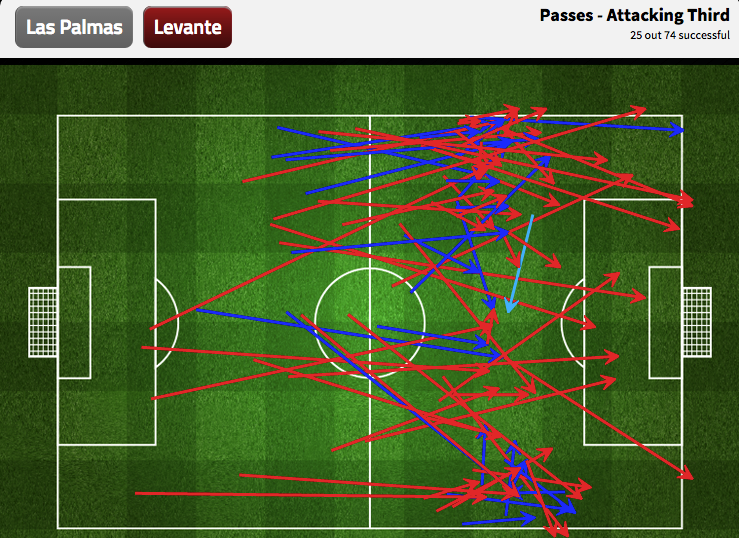 Villarreal have the most worrying signs of any big team early despite topping the table. They and their opponents are spending about equal amounts of time in front of goal and they’ve taken the fewest shots from inside 10 yards of any team in the league: 4. This despite a easy early schedule. A loss in the Europa League has added to the worries. Last year Villarreal and Valencia were the best teams in Europe at keeping dangerous possession from being turned into shots. That's something that will likely be very hard to repeat in as offenses generally control things a defense simply can't. To make a Champions League run, Villarreal can't fall victim to the "World Series rut" right now. In baseball teams that win the World Series often assume they need to just keep doing what they are doing and similar results will follow. Hungrier teams tend to outperform the sated champs, the message being: always be improving. Postscript: Deep completion and shot on target numbers
Villarreal have the most worrying signs of any big team early despite topping the table. They and their opponents are spending about equal amounts of time in front of goal and they’ve taken the fewest shots from inside 10 yards of any team in the league: 4. This despite a easy early schedule. A loss in the Europa League has added to the worries. Last year Villarreal and Valencia were the best teams in Europe at keeping dangerous possession from being turned into shots. That's something that will likely be very hard to repeat in as offenses generally control things a defense simply can't. To make a Champions League run, Villarreal can't fall victim to the "World Series rut" right now. In baseball teams that win the World Series often assume they need to just keep doing what they are doing and similar results will follow. Hungrier teams tend to outperform the sated champs, the message being: always be improving. Postscript: Deep completion and shot on target numbers 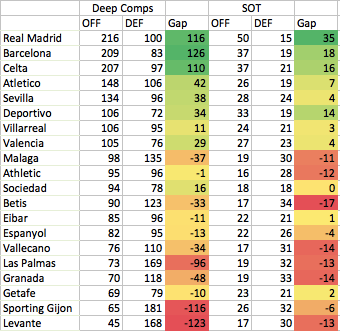
Month: September 2015
The Bad Times Will Pass: Brendan Rodgers, Confidence And Misfiring Forwards
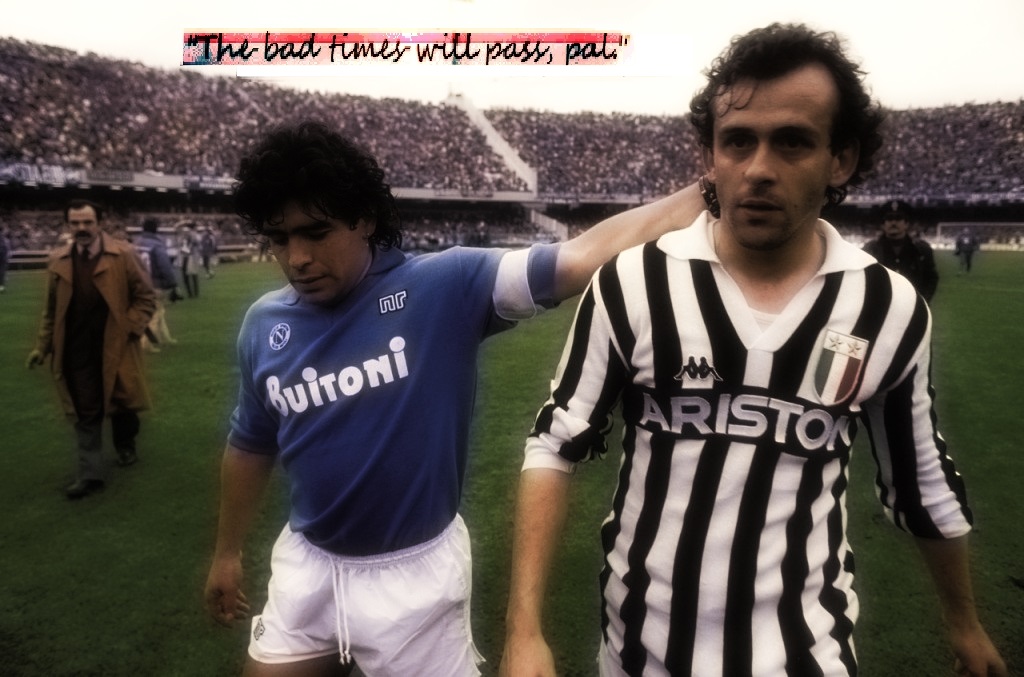 It was one of those weekends. Goals everywhere, shots aplenty and in some regard reversion to the old order. In itself, Saturday was a match day like few before it. We've seen plenty of goals before but rarely, if ever, have we seen so many shots land on target. The season average across the league is 4.5 per team per game and Saturday offered up 6.7 each. I've checked back and I can find no weekend any higher than 5.9 across six seasons, so it was a tough week for goalkeepers to earn their corn. It was inevitable that Palace and Watford would play a grindy match on Sunday that brought the average down. But still... Maybe it was the weird conjunction of a lunar eclipse and a super moon, and now civilisation is hanging by a thread and you're reading this in a bunker, wondering how the internet is still functioning despite the apocalyptic scenes outside? Or maybe sport just does this kind of thing sometimes and is best enjoyed as the genuinely lunatic spectacle it can sometimes be. Regardless, amongst the chaos a fair few inevitable events took place. After noting last week how other than United, all of last year's top seven had been under-performing in shot conversions, the four chief strugglers all perked up. Liverpool netted thrice, as did Southampton, Tottenham found one more, with four and Arsenal did something they had promised to do all year by pulling in the full handful. Having taken at least 19 shots in each of their games other than the Chelsea loss, a continuation of this trend would surely eventually precipitate a glut of goals. And so it proved against a team that have been on a hard-to-sustain run of correct coin calling all season- Leicester. That this married so kindly with the reawakening of Alexis Sanchez' relationship with finishing tidied that non-storyline away too. Elsewhere player-wise, Kane and Depay also thankfully dispatched their dreary non-scoring narratives netwards and Kane in particular was quick to note: "I am a confident young man, and I have faith in my ability." A real bombshell, huh? Compare to what we've been hearing relentlessly all season... Is it too much to wish for a world in which the wider media can reliably distinguish between confidence and a lack of confidence? Or even move on from the whole issue of confidence, when quite obviously so few people can identify it reliably? Far too often we see lazy interpretations of otherwise identical events framed by a pre-conceived perception of a presumed mind-set of the player in question. How about scratching beneath the surface and looking for evidence to support the conclusion rather than merely relying on gut feeling and unqualified "expertise"? In 2015, we find ourselves in a situation where repeatedly in commentary, player decisions are referenced immediately against an alternative close in proximity: "He should have shot there", " Could he not see the pass was on?", "A confident Harry Kane plays his team mate in there"- as a clearly unfazed Kane fires one slightly wide. There are many culprits. Tottenham! Decisive Win! The confidence issue had been thrust at Mauricio Pochettino prior to the City game, and he'd danced around it in his typical manner of saying a lot whilst informing very little. This is less a language barrier than a coherence barrier, similar to the one Villas Boas employed, in which insight runs a poor second to filler and we are rarely the wiser for his media interactions. And this is important because this season, questions of confidence appear secondary to this team. They appear to be unaffected by opposition or circumstance and are seemingly capable of enacting and "executing the gameplan" and imposing their play upon the opposition rather than otherwise. This ethos was in danger of coming up short against Man City- and there would have been little shame in that- but in a badly officiated match, the balance of decisions landed on Tottenham's side and Erik Lamela found favour once more. In a direct contrast to the matches between van Gaal and Pochettino's Tottenham, which have repeatedly incorporated a tiny number of shots on goal-18, 16 and 18- Pellegrini and Pochettino's styles seem to generate the opposite effect. The two games in which Man City conceded the highest volume of shots last season were the two fixtures against Tottenham, and although they won both of them, Tottenham weren't without chances in each game. This weekend's match featured both teams fashioning eight shots on target, and 37 total shots to go with the 39 and 36 from last year, and with this degree of openness, the variety of possible results on the table quite obviously increases. That Tottenham should come out on the positive side of this type of game is not inevitable, but nor is it as unlikely as it might initially seem. Is it possible that having recorded a series of positive results against Tottenham, Man City approached this game with a high level of confidence, perhaps overconfidence? A direct and clear divergence from the extreme caution that seems to characterise van Gaal's style? But then, of course, I would be falling into the same trap that i've warned of already. Confidence is tricky to ascertain with any accuracy and I prefer to retain an analysis that open styles, lenient officials and an absence of key personnel for City as being the predominant drivers here. And to paint a positive picture of Tottenham, Lamela, Eriksen, Son and Kane is a front four that offers great diversity and genuine talent. It is my hope that they will be retained in their roles going forward. The Bad Times Will Pass, Pal
It was one of those weekends. Goals everywhere, shots aplenty and in some regard reversion to the old order. In itself, Saturday was a match day like few before it. We've seen plenty of goals before but rarely, if ever, have we seen so many shots land on target. The season average across the league is 4.5 per team per game and Saturday offered up 6.7 each. I've checked back and I can find no weekend any higher than 5.9 across six seasons, so it was a tough week for goalkeepers to earn their corn. It was inevitable that Palace and Watford would play a grindy match on Sunday that brought the average down. But still... Maybe it was the weird conjunction of a lunar eclipse and a super moon, and now civilisation is hanging by a thread and you're reading this in a bunker, wondering how the internet is still functioning despite the apocalyptic scenes outside? Or maybe sport just does this kind of thing sometimes and is best enjoyed as the genuinely lunatic spectacle it can sometimes be. Regardless, amongst the chaos a fair few inevitable events took place. After noting last week how other than United, all of last year's top seven had been under-performing in shot conversions, the four chief strugglers all perked up. Liverpool netted thrice, as did Southampton, Tottenham found one more, with four and Arsenal did something they had promised to do all year by pulling in the full handful. Having taken at least 19 shots in each of their games other than the Chelsea loss, a continuation of this trend would surely eventually precipitate a glut of goals. And so it proved against a team that have been on a hard-to-sustain run of correct coin calling all season- Leicester. That this married so kindly with the reawakening of Alexis Sanchez' relationship with finishing tidied that non-storyline away too. Elsewhere player-wise, Kane and Depay also thankfully dispatched their dreary non-scoring narratives netwards and Kane in particular was quick to note: "I am a confident young man, and I have faith in my ability." A real bombshell, huh? Compare to what we've been hearing relentlessly all season... Is it too much to wish for a world in which the wider media can reliably distinguish between confidence and a lack of confidence? Or even move on from the whole issue of confidence, when quite obviously so few people can identify it reliably? Far too often we see lazy interpretations of otherwise identical events framed by a pre-conceived perception of a presumed mind-set of the player in question. How about scratching beneath the surface and looking for evidence to support the conclusion rather than merely relying on gut feeling and unqualified "expertise"? In 2015, we find ourselves in a situation where repeatedly in commentary, player decisions are referenced immediately against an alternative close in proximity: "He should have shot there", " Could he not see the pass was on?", "A confident Harry Kane plays his team mate in there"- as a clearly unfazed Kane fires one slightly wide. There are many culprits. Tottenham! Decisive Win! The confidence issue had been thrust at Mauricio Pochettino prior to the City game, and he'd danced around it in his typical manner of saying a lot whilst informing very little. This is less a language barrier than a coherence barrier, similar to the one Villas Boas employed, in which insight runs a poor second to filler and we are rarely the wiser for his media interactions. And this is important because this season, questions of confidence appear secondary to this team. They appear to be unaffected by opposition or circumstance and are seemingly capable of enacting and "executing the gameplan" and imposing their play upon the opposition rather than otherwise. This ethos was in danger of coming up short against Man City- and there would have been little shame in that- but in a badly officiated match, the balance of decisions landed on Tottenham's side and Erik Lamela found favour once more. In a direct contrast to the matches between van Gaal and Pochettino's Tottenham, which have repeatedly incorporated a tiny number of shots on goal-18, 16 and 18- Pellegrini and Pochettino's styles seem to generate the opposite effect. The two games in which Man City conceded the highest volume of shots last season were the two fixtures against Tottenham, and although they won both of them, Tottenham weren't without chances in each game. This weekend's match featured both teams fashioning eight shots on target, and 37 total shots to go with the 39 and 36 from last year, and with this degree of openness, the variety of possible results on the table quite obviously increases. That Tottenham should come out on the positive side of this type of game is not inevitable, but nor is it as unlikely as it might initially seem. Is it possible that having recorded a series of positive results against Tottenham, Man City approached this game with a high level of confidence, perhaps overconfidence? A direct and clear divergence from the extreme caution that seems to characterise van Gaal's style? But then, of course, I would be falling into the same trap that i've warned of already. Confidence is tricky to ascertain with any accuracy and I prefer to retain an analysis that open styles, lenient officials and an absence of key personnel for City as being the predominant drivers here. And to paint a positive picture of Tottenham, Lamela, Eriksen, Son and Kane is a front four that offers great diversity and genuine talent. It is my hope that they will be retained in their roles going forward. The Bad Times Will Pass, Pal 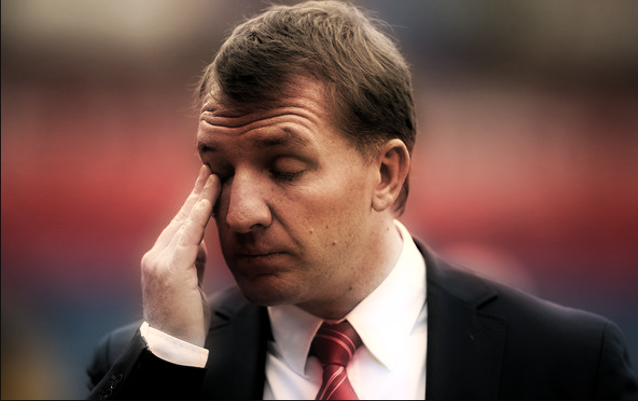 Brendan Rodgers' role has been called into question on many occasions since the 2013-14 near miss. In the modern game, surviving on the goodwill generated by one good season is not guaranteed, but the intransigence of FSG and a general sense of fairness allowed him to shepherd Gerrard into the minor leagues, cosset Sterling towards his big move and spend a year wondering how he went from the best strike force in recent league memory to being reluctant to field anyone up front. As the season meandered away from the cusp of Champions League qualification and turned to shit, even my support for Brendan- conceptually, as a coach that could create solid numbers from his squad- started to waver, and had he left in May, it would have been difficult to build a cogent case to retain him. The decline and defeat at Stoke was that bad, up there with the defeat that Rodgers himself supervised that ended Villas-Boas' tenure at Tottenham, that it seemed likely that he had to go. But the owners retained him, and they also backed him with another array of potentially useful signings and allowed the dice to tumble freely from their organisational hands, hoping once again, to land the big score. That the early weeks have been uninspiring has been entirely predictable to us seasoned Brendan watchers- his teams never start well- so that the fan base has seemingly decided in a large way to turn on him, although understandable, appears a little short sighted. Only Arsenal are finding a way to convert their goal bound shots less frequently that Liverpool, and that 19th place ranking is ably accompanied by a 17th place rank for all shots. With concern that too many efforts are flying from the boot of a mid-pitch positioned Coutinho, the return of Sturridge's nose for goal was a huge fillip this last weekend, but realistically, these conversion rates will improve. As will the dismal 59% save percentage. That gives us underwhelming figures at both ends of the conversion numbers. Worry not fans, there is a ton of leeway in a PDO of under 80 and if it doesn't kill the coach, he can ride the wave as it reemerges into something more normal. The vital numbers look fine: "shots for" levels are enough to rank top six so far and the only bad "shots against" game was when they shut-out Arsenal, who as we learned earlier shoot frequently against nearly everyone. Defense may be winning the day, for now, and the base for future success is reasonably solid. The 47 shots against Carlisle was an extreme example, and in the way it has been used as a stick to beat him with is reminiscent of Moyes' 81 crosses against Fulham. In itself it represented an erroneous focus on shooting for shooting's sake but a team's real problems arise when the shots dry up, and that simply hasn't happened. It would simply make no sense to remove Rodgers at this point having restructured the coaching department and given him half a new team. Last May was fine, or even June- rebuild from that point- and if after reaching twelve or fifteen games, Liverpool are firmly mid-table, then maybe there is some logic in sacking him. Until then, the smart thing for Liverpool to do is hold fire, see how the team progresses and make decisions when they have a solid process behind them rather than as a reactionary sop to the more skittish elements of the fan base. For if the process is faulty, the buck eventually stops with the decision makers that FSG have empowered, not the coach. ___________________ Thanks for reading! Follow me on Twitter @jair1970
Brendan Rodgers' role has been called into question on many occasions since the 2013-14 near miss. In the modern game, surviving on the goodwill generated by one good season is not guaranteed, but the intransigence of FSG and a general sense of fairness allowed him to shepherd Gerrard into the minor leagues, cosset Sterling towards his big move and spend a year wondering how he went from the best strike force in recent league memory to being reluctant to field anyone up front. As the season meandered away from the cusp of Champions League qualification and turned to shit, even my support for Brendan- conceptually, as a coach that could create solid numbers from his squad- started to waver, and had he left in May, it would have been difficult to build a cogent case to retain him. The decline and defeat at Stoke was that bad, up there with the defeat that Rodgers himself supervised that ended Villas-Boas' tenure at Tottenham, that it seemed likely that he had to go. But the owners retained him, and they also backed him with another array of potentially useful signings and allowed the dice to tumble freely from their organisational hands, hoping once again, to land the big score. That the early weeks have been uninspiring has been entirely predictable to us seasoned Brendan watchers- his teams never start well- so that the fan base has seemingly decided in a large way to turn on him, although understandable, appears a little short sighted. Only Arsenal are finding a way to convert their goal bound shots less frequently that Liverpool, and that 19th place ranking is ably accompanied by a 17th place rank for all shots. With concern that too many efforts are flying from the boot of a mid-pitch positioned Coutinho, the return of Sturridge's nose for goal was a huge fillip this last weekend, but realistically, these conversion rates will improve. As will the dismal 59% save percentage. That gives us underwhelming figures at both ends of the conversion numbers. Worry not fans, there is a ton of leeway in a PDO of under 80 and if it doesn't kill the coach, he can ride the wave as it reemerges into something more normal. The vital numbers look fine: "shots for" levels are enough to rank top six so far and the only bad "shots against" game was when they shut-out Arsenal, who as we learned earlier shoot frequently against nearly everyone. Defense may be winning the day, for now, and the base for future success is reasonably solid. The 47 shots against Carlisle was an extreme example, and in the way it has been used as a stick to beat him with is reminiscent of Moyes' 81 crosses against Fulham. In itself it represented an erroneous focus on shooting for shooting's sake but a team's real problems arise when the shots dry up, and that simply hasn't happened. It would simply make no sense to remove Rodgers at this point having restructured the coaching department and given him half a new team. Last May was fine, or even June- rebuild from that point- and if after reaching twelve or fifteen games, Liverpool are firmly mid-table, then maybe there is some logic in sacking him. Until then, the smart thing for Liverpool to do is hold fire, see how the team progresses and make decisions when they have a solid process behind them rather than as a reactionary sop to the more skittish elements of the fan base. For if the process is faulty, the buck eventually stops with the decision makers that FSG have empowered, not the coach. ___________________ Thanks for reading! Follow me on Twitter @jair1970
Reconstruction of Olympique Lyonnais
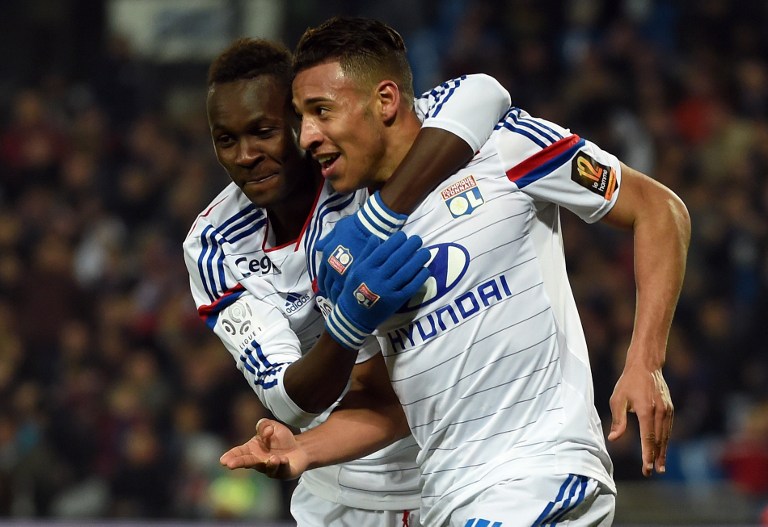 No one, and I repeat, no one could have expected what came from Olympique Lyonnais last season. Lyon were still at a point financially where they had to solely rely on their famous youth academy to get them by as their new stadium was still being constructed. It's been that way for the last few years with Lyon as player transfer spending was cut dramatically. After having a seven year peak of dominating French football and being a relevant power in Europe, Lyon went through an awkward transition period that saw them significantly drop. It was super exciting to see Lyon have the season they did. It was a nice blend of the young talent that came through the youth academy with the veteran talent that was still present. Alexandre Lacazette went from a solid striker to one of the hottest properties in Europe. Nabil Fekir looked like a potential once in a generation caliber player while Clinton N'Jie had his electrifying moments as part of Lyon's attacking three, which helped him foster his move to Tottenham this summer. The success of last year and the new stadium being ready to open in January 2016 allowed Lyon to do something they haven't done in years: spend money on players. Lyon had a net spend of €14.4M this summer, the highest it's been since 2010-11. It was a clear sign of intention that Jean-Michel Aulas wanted Lyon to be back as a permanent Champions League participant for years to come and get close to the heights they attained previously during the 2000's. Full disclosure: I didn't think Lyon would be anywhere close to PSG this season, even before the Nabil Fekir ACL tear. In the stupidly long preview I did for Ligue 1 this season, I thought that while talented, Lyon benefitted from a lot of things going their way (one of them being PSG were in a state of flux) and they probably wouldn't get that same luck again. In many ways, I thought were a junior version of 2013-14 Liverpool. Combine that with PSG getting a game changer in Angel Di Maria and asking Lyon to replicate what they did last season was almost to the point of dreaming. Even with the probable chance for regression, I thought Lyon would be more vibrant to start the season and could nestle in as the best of the rest in France. I liked the addition of Claudio Beauvue (but more so under the impression that they would keep N'Jie), and adding Mathieu Valbuena was a calculated risk. A front three of Valbuena/Fekir/Lacazette on paper was really talented, even though a decent argument could be made that Valbuena and Fekir overlap somewhat stylistically. Before the knee injury to Fekir, Lyon's attack could be best described as insipid. It didn't help that Lacazette was carrying a back injury for the first few weeks. Only against Caen did Lyon look half decent going forward, and that was mostly due to Fekir going supernova. The pace of play was too slow for what Lyon would ideally like to do, and teams congested the middle to effectively dare Lyon to create from crosses. Lyon were in the bottom three last season in crosses per game and chances created from crosses. What made Lyon super interesting last year was that their style and numbers didn't really intersect each other. Last season Lyon were the high flying club that had good but not close to great shot numbers. This season is somewhat more opposite; Lyon haven't looked special visually but their underlying data looks pretty solid. They're 6th in expected points at 13.89 points, 5th in expected goal difference, 2nd in shots on target ratio and 2nd in Team Rating. Perhaps the best thing for Lyon is that they've slowly started to look better visually as well. Valbuena was great against Marseille (especially considering Marseille tried to kick him off the pitch), Lacazette in his last two games has looked alive and more like himself and their midfield has looked good. Yes they lost 3-1 to Bordeaux on Saturday, but that looked a more or less a pretty freaky result. A good portion of Lyon's really good statistical numbers has been due to their defense. I thought Anthony Lopes made Lyon's defense look a hell of a lot better than it should've. He did for them, what Hugo Lloris did for Spurs (While we're at it, I think Anthony Lopes is going to have a better peak than Hugo Lloris and we'll talk about him as one of the better goalies in Europe very soon). This season, Lopes hasn't been needed quite as much as he was last year. Lyon rank second in expected goals against, and have given up the least amount of shots in the danger zone this season. And it's not like the schedule has even been that easy for them. They've played Bordeaux, Caen and Marseille on the road, three of the better attacking teams in France. It seems like the best midfield three for Lyon could be Maxime Gonalons, Corentin Tolisso and Sergi Darder. Statistically, Tolisso is pretty average in the standard metrics we use to look at midfielders, but I love his game and his ability to either make runs into the penalty area or drop back at a moment's notice and be the deepest midfielder. It also helps that he could probably play 3-4 positions on the field at an adequate-very good level. Gonalons is good, albeit he might be slightly overrated, but nonetheless, still quality and Darder looked really promising versus Marseille. Lyon's CB core of Samuel Umtiti, Milan Bisevac and Mapou Yanga-Mbiwa is solid and Bakary Kone as a 4th CB is a hell of a lot better than him having to play over 2000 minutes. I just wish that I was more confident in their ability to create offense, which again is weird considering what they did last season. As much as I love Lacazette as a talent, there are massive red flags with his ability replicate something close to his 19 non penalty goal output. The Fekir injury was just a bummer. He really looked like he was announcing himself as the next big thing in Europe who would be courted by mega clubs very soon. Beauvue/Lacazette as a front pairing hasn't been inspiring and just like Valbuena/Fekir, the striker duo have issues as a tandem. In a sad way, the Fekir injury will probably be good news for Valbuena as he now gets to be the creative force for Lyon. Also the performance of Aldo Kalulu versus Bastia during the midweek was very promising. He's another young attacking player with pace that's come up from the youth academy. If Kalulu could be this year's Clinton N'Jie, it would make the front three flow much seamlessly. If Lyon's defense can play at this sort of level throughout the entire season and limit their dependence on Lopes' brilliance to a minimum, they'll finish as one of the three best teams in Ligue 1 even if the attack remains in this type of state. The contenders around them have their own warts that are arguably more telling. Monaco look like an absolute mess in defense, Marseille have been in a state of chaos since Marcelo Bielsa left, Nice have all the lucky horseshoes a team could possibly acquire and Saint Etienne have been okay so far but have been the beneficiaries of a favorable schedule + red cards . Just how much Lyon's attack can recover could be the difference between a top 3 finish and perhaps the faint hopes of a title challenge in Ligue 1.
No one, and I repeat, no one could have expected what came from Olympique Lyonnais last season. Lyon were still at a point financially where they had to solely rely on their famous youth academy to get them by as their new stadium was still being constructed. It's been that way for the last few years with Lyon as player transfer spending was cut dramatically. After having a seven year peak of dominating French football and being a relevant power in Europe, Lyon went through an awkward transition period that saw them significantly drop. It was super exciting to see Lyon have the season they did. It was a nice blend of the young talent that came through the youth academy with the veteran talent that was still present. Alexandre Lacazette went from a solid striker to one of the hottest properties in Europe. Nabil Fekir looked like a potential once in a generation caliber player while Clinton N'Jie had his electrifying moments as part of Lyon's attacking three, which helped him foster his move to Tottenham this summer. The success of last year and the new stadium being ready to open in January 2016 allowed Lyon to do something they haven't done in years: spend money on players. Lyon had a net spend of €14.4M this summer, the highest it's been since 2010-11. It was a clear sign of intention that Jean-Michel Aulas wanted Lyon to be back as a permanent Champions League participant for years to come and get close to the heights they attained previously during the 2000's. Full disclosure: I didn't think Lyon would be anywhere close to PSG this season, even before the Nabil Fekir ACL tear. In the stupidly long preview I did for Ligue 1 this season, I thought that while talented, Lyon benefitted from a lot of things going their way (one of them being PSG were in a state of flux) and they probably wouldn't get that same luck again. In many ways, I thought were a junior version of 2013-14 Liverpool. Combine that with PSG getting a game changer in Angel Di Maria and asking Lyon to replicate what they did last season was almost to the point of dreaming. Even with the probable chance for regression, I thought Lyon would be more vibrant to start the season and could nestle in as the best of the rest in France. I liked the addition of Claudio Beauvue (but more so under the impression that they would keep N'Jie), and adding Mathieu Valbuena was a calculated risk. A front three of Valbuena/Fekir/Lacazette on paper was really talented, even though a decent argument could be made that Valbuena and Fekir overlap somewhat stylistically. Before the knee injury to Fekir, Lyon's attack could be best described as insipid. It didn't help that Lacazette was carrying a back injury for the first few weeks. Only against Caen did Lyon look half decent going forward, and that was mostly due to Fekir going supernova. The pace of play was too slow for what Lyon would ideally like to do, and teams congested the middle to effectively dare Lyon to create from crosses. Lyon were in the bottom three last season in crosses per game and chances created from crosses. What made Lyon super interesting last year was that their style and numbers didn't really intersect each other. Last season Lyon were the high flying club that had good but not close to great shot numbers. This season is somewhat more opposite; Lyon haven't looked special visually but their underlying data looks pretty solid. They're 6th in expected points at 13.89 points, 5th in expected goal difference, 2nd in shots on target ratio and 2nd in Team Rating. Perhaps the best thing for Lyon is that they've slowly started to look better visually as well. Valbuena was great against Marseille (especially considering Marseille tried to kick him off the pitch), Lacazette in his last two games has looked alive and more like himself and their midfield has looked good. Yes they lost 3-1 to Bordeaux on Saturday, but that looked a more or less a pretty freaky result. A good portion of Lyon's really good statistical numbers has been due to their defense. I thought Anthony Lopes made Lyon's defense look a hell of a lot better than it should've. He did for them, what Hugo Lloris did for Spurs (While we're at it, I think Anthony Lopes is going to have a better peak than Hugo Lloris and we'll talk about him as one of the better goalies in Europe very soon). This season, Lopes hasn't been needed quite as much as he was last year. Lyon rank second in expected goals against, and have given up the least amount of shots in the danger zone this season. And it's not like the schedule has even been that easy for them. They've played Bordeaux, Caen and Marseille on the road, three of the better attacking teams in France. It seems like the best midfield three for Lyon could be Maxime Gonalons, Corentin Tolisso and Sergi Darder. Statistically, Tolisso is pretty average in the standard metrics we use to look at midfielders, but I love his game and his ability to either make runs into the penalty area or drop back at a moment's notice and be the deepest midfielder. It also helps that he could probably play 3-4 positions on the field at an adequate-very good level. Gonalons is good, albeit he might be slightly overrated, but nonetheless, still quality and Darder looked really promising versus Marseille. Lyon's CB core of Samuel Umtiti, Milan Bisevac and Mapou Yanga-Mbiwa is solid and Bakary Kone as a 4th CB is a hell of a lot better than him having to play over 2000 minutes. I just wish that I was more confident in their ability to create offense, which again is weird considering what they did last season. As much as I love Lacazette as a talent, there are massive red flags with his ability replicate something close to his 19 non penalty goal output. The Fekir injury was just a bummer. He really looked like he was announcing himself as the next big thing in Europe who would be courted by mega clubs very soon. Beauvue/Lacazette as a front pairing hasn't been inspiring and just like Valbuena/Fekir, the striker duo have issues as a tandem. In a sad way, the Fekir injury will probably be good news for Valbuena as he now gets to be the creative force for Lyon. Also the performance of Aldo Kalulu versus Bastia during the midweek was very promising. He's another young attacking player with pace that's come up from the youth academy. If Kalulu could be this year's Clinton N'Jie, it would make the front three flow much seamlessly. If Lyon's defense can play at this sort of level throughout the entire season and limit their dependence on Lopes' brilliance to a minimum, they'll finish as one of the three best teams in Ligue 1 even if the attack remains in this type of state. The contenders around them have their own warts that are arguably more telling. Monaco look like an absolute mess in defense, Marseille have been in a state of chaos since Marcelo Bielsa left, Nice have all the lucky horseshoes a team could possibly acquire and Saint Etienne have been okay so far but have been the beneficiaries of a favorable schedule + red cards . Just how much Lyon's attack can recover could be the difference between a top 3 finish and perhaps the faint hopes of a title challenge in Ligue 1.
Caen You Believe It
It seems like ages ago, but at the midway point of last season, Caen were a team that looked under real threat of relegation. It wasn't a huge surprise, as Caen have had a pretty volatile history in terms of being able to stay up in Ligue 1. In their last 15 completed seasons, they've only been in the top flight in France for six of them. After 19 games last season, Caen were dead last in Ligue 1 with only 15 points. The three teams that got relegated last season in Ligue 1 were at least four points ahead of Caen at that point, and they looked like a sunk cost.
From that point to now, they've accumulated 43 points through 25 games, a points per game pace of 1.72. Over a full uninterrupted season that would amount to around a 65-66 point side. That's been good enough in two of the past six seasons to secure a Champions League spot. It's quite remarkable just how successful Caen have been over the last 25 games. In ways it's reminiscent of Leicester's rise in the English Premier League, but for a longer span of time. During their extended surge they've beaten the likes of Saint Etienne and Marseille, the latter of which was one of the best games in European football last season. Their expected points total last season was 47.7, which suggests that their total output of 46 was more or less what they should've expected.
The way Caen set up tactically is pretty interesting and at times can lead towards insanity. In an age where the double pivot is the go-to formation, Caen don't play with a two man holding midfield and instead play some form of 4-1-4-1 formation. It's built on counter attacking at will and very quick transitions, creating structural chaos. In many ways their playing style is the equivalent of say Crystal Palace or even Hoffenheim during the past couple of seasons, just with considerably less talent.
Despite the 4-0 loss versus Lyon, they went toe-to-toe and were hard done by Nabil Fekir's best impersonation of Lionel Messi. The degree to which how far back Caen sit back and try to make do with quick bursts is quite astounding. Caen through six games this season are last with 39.6% possession and have conceded the 2nd most final third passes in Ligue 1. Last season Caen ranked 2nd last in possession as well. In terms of pressing, Caen ranked in the bottom three in France last season and that hasn't deviated much this season as well.
Perhaps the biggest worry for a club like Caen is that the degree to which they sit back and defend deep could eventually bite them in the butt. They truly only have one style of play and at some point teams in France will start to figure that out. The likes of PSG, Marseille and at times Lyon are the type of clubs that can pick apart a defense that deep. On a much much much larger scale, that's sort of happened to Borussia Dortmund during the latter stages of the Jurgen Klopp era. Teams slowly started to figure out the flaws of incessant gengenpressing without a true Plan B and counteracted it (mind you they were also very unlucky in terms of both health and statistically but that's already been discussed ).
For now though Caen won't have to worry about how one dimensional they are because they've started to become better defensively. Caen last season were awful in that area, ranking in the bottom three in expected goals conceded at 51.5. This season, they rank 5th. Though they've given up the 2nd most final third passes, that hasn't led to too much shots in dangerous areas. It has taken Caen opponents on average 35.7 final third passes to register a danger zone shot (shots coming from the central area), which ranks 4th in Ligue 1. PSG, Rennes and Angers are the three clubs ahead of them; teams that are very compact defensively.
Even going forward, Caen have been better than they were last season. Their expected goals per game has gone from middle of the pack to the top 5-6, Caen rank 6th in both big chances created and danger zone shots created and this is being done despite a goals/shots on target conversion rate that is 13th in Ligue 1. Last season, Caen had the 4th highest conversion in Ligue 1.
Despite the clear progress that has come for Caen this season, according to the expected points tally I have for Ligue 1, Caen have overachieved by 4.12 points this season, the highest in Ligue 1. This could be due to the fact that Caen have a PDO of 93.4. I tried looking at different other regressions for Caen and they came out much more favorably for them, suggesting that their talent level so far is of a 9-10 point team. Mind you it's still over-performing their current total of 12 points but not to such a high degree.
The good news for Caen this season is that they've cushioned the departures of N'golo Kante (Leicester), Thomas Lemar (Monaco) and Lenny Nangis (Lille) really well so far, probably better than expected. They also were the beneficiary of productive loan acquisitions in Emiliano Sala and Nicolas Benezet, and they've gone to Nantes and Guingamp respectively. For a club as small as Caen and without much in the way of money, being able to get by in house is key to survival.
It also helps that there's some form of core to lean on. Julian Feret is still a very classy playmaker even if he's on the wrong side of 30. Herve Bazile is an underrated winger who's in his prime years and Damien da Silva is dependable to suck up close to 3000 minutes at CB. Caen did make one big signing this summer, and that was for Andy Delort from Wigan. Through six games this season, he's been a perfect fit for them producing at a clip of 4.5 shots per 90, a non penalty goal rate of 0.33 with an expected goals output of 0.41 per 90. He's quick and can run through the channels, which plays right into how Caen play with the quick hitting passing.
It also helps that he has a rocket of a right foot. It was his goal that stood as the game winner versus Marseille in their 1-0 season opening win. Delort's goal scoring record outside his 2013/14 season with Tours in Ligue 2 has been uninspiring, but perhaps this is the club that extracts the best out of him in a Riyad Mahrez like fashion.
Caen are evolving from a fun novelty act into a more sustainable version of that, but without losing the charm that makes them a very entertaining team to watch for the neutrals. In many ways, they're the antithesis of the ethos that some people think of when it comes to Ligue 1. They're super quick on the counter and even with the progress defensively, they still give off the feel of a "bend but don't break" defense which doesn't exist too often in Ligue 1. There's genuine talent at the club and who knows just how good Andy Delort could be this season. Of course there's the dreaded small sample size alert hovering around success stories like Caen, and it's totally fair. We've seen so many fairytale stories that have gone awry that it should be taken with some form of salt.
But it shouldn't be out of the question that Caen could finish around 9th-11th this season. The field in Ligue 1 is pretty uninspiring once you get past the top 6-8 clubs. Montpellier look awful so far, Bastia are shooting fireballs out of their behinds (60% G/SoT rate!!!), Nantes can't create offense to save their lives and two of the three promoted teams from last season look like a safe bet to return back to Ligue 2. Assuming Caen don't get bit by injury luck, a mid table finish is possible if their underlying data continues to hover around a decent level.
One of the best stories going in France, Caen are a fun alternative to the likes of Nantes and Rennes who play slow, methodical football. Variety is the spice of life, and Caen have certainly added a few doses of that in Ligue 1.
Find me on Twitter: @MoeSquare
Elephants In The Room: West Ham, Leicester and Man Utd
 We've rapidly reached the six game mark in the 2015-16 Premier League season and slowly but surely some storylines are taking shape. Of course, if you are a regular reader of the content here on Stats Bomb you will be well aware of the duality of league storylines. Some exist on the surface powered by results and the table and are hammered repeatedly by the wider media. Others, and largely the ones we are interested in, bubble lightly beneath the surface, visible to those who look a little closer for a sharper perspective. These are fundamental truths and there is no secret surrounding them, so let's delve in amongst the murk and see what we can pull out. The Elephant In The Room 1: Leicester Leicester are having a great time. Unbeaten in six games, goals aplenty and one of the league's early stars in Riyad Mahrez. How good would it be if he could pull a Bale or Suarez and carry his team to previously unimagined heights? To pitch hard for a European slot, to maintain the run and bring overdue footballing glories back to the East Midlands? They are clawing back and overturning deficits like a latter year Ferguson team and clearly have a ton of energy and pace but there are aspects of their numbers that are shining like a beacon and suggest that their coin isn't going to keep coming down heads. They rank second in the league for all shot conversion (16%) and second in the league for goals per shot on target (45%); when league averages are 9.5% and 28%, we can see these numbers are clearly in orbit. On the flip side, they are ranking fourth in the "against" side of these metrics, which shows that they have struggled to control the opposition, hence the deficits, and hence the obvious conclusion that if you turn your games into basketball style Ossie Ardiles-managed shoot-outs, eventually the coin will start to land on tails. There has been a little debate recently around measuring of team talent, and over how long can you measure a team before you can be confident of their true quality. With football a game of limited fixtures in comparison to the more metric attuned North American sports, i'm firmly of the opinion that sample sizes limit the efficiency of rating teams in the short term, and linked to this, we can see that Leicester's positive run throughout the majority of 2015 has been powered in part by high conversion rates. Specifically over the last 19 games of last season they posted a 40% goals to shots on target rate and 12% all shot conversion. In that period their defence was posting par numbers, and their safety was secured. But it suggests that even 25 games can disguise a team's quality, unless you choose to believe that Leicester are of the class to challenge for Europe, and if we find the league table disguising the truth over this length of games, it's far from a stretch to understand that whole seasons can pass with similar results. But, in Leicester's favour: so far this season their shot numbers are pretty solid, and certainly nowhere near a level that should see them struggle long term. Mercifully, Claudio Ranieri is far too grizzled to fall for any hype around his team and was quoted last week playing down expectations: “We want to achieve the 40 points- to maintain [our position in the] Premier League is our goal. That is important for us" Quite. The Elephant In The Room 2: West Ham West Ham are having a great time. Four wins in six games, goals aplenty and one of the league's early stars in Dimitri Payet. How good would it be if he could pull a Bale or Suarez and carry his team to previously unimagined heights? To pitch hard for a European slot, to maintain the run and bring overdue footballing glories back to East London? In their current favour they sit third and lead the league alongside Leicester for goals scored with thirteen. They have also picked up three extremely hard to predict away wins and have ridden happily through a tough schedule. However, where we can suggest that parts of Leicester's form are positive and potentially sustainable, like their shot rates, West Ham's underlying numbers provide a delightful early storyline that points in only one direction: massive potential reversion. So extreme is their skew that it can be approached from multiple angles. The wider analytics community is already on this. Steve McCarthy's expected goals model places West Ham 18th, Paul Riley's subtly different expected goals model also places them 18th. Objectivefooty has picked this up too:
We've rapidly reached the six game mark in the 2015-16 Premier League season and slowly but surely some storylines are taking shape. Of course, if you are a regular reader of the content here on Stats Bomb you will be well aware of the duality of league storylines. Some exist on the surface powered by results and the table and are hammered repeatedly by the wider media. Others, and largely the ones we are interested in, bubble lightly beneath the surface, visible to those who look a little closer for a sharper perspective. These are fundamental truths and there is no secret surrounding them, so let's delve in amongst the murk and see what we can pull out. The Elephant In The Room 1: Leicester Leicester are having a great time. Unbeaten in six games, goals aplenty and one of the league's early stars in Riyad Mahrez. How good would it be if he could pull a Bale or Suarez and carry his team to previously unimagined heights? To pitch hard for a European slot, to maintain the run and bring overdue footballing glories back to the East Midlands? They are clawing back and overturning deficits like a latter year Ferguson team and clearly have a ton of energy and pace but there are aspects of their numbers that are shining like a beacon and suggest that their coin isn't going to keep coming down heads. They rank second in the league for all shot conversion (16%) and second in the league for goals per shot on target (45%); when league averages are 9.5% and 28%, we can see these numbers are clearly in orbit. On the flip side, they are ranking fourth in the "against" side of these metrics, which shows that they have struggled to control the opposition, hence the deficits, and hence the obvious conclusion that if you turn your games into basketball style Ossie Ardiles-managed shoot-outs, eventually the coin will start to land on tails. There has been a little debate recently around measuring of team talent, and over how long can you measure a team before you can be confident of their true quality. With football a game of limited fixtures in comparison to the more metric attuned North American sports, i'm firmly of the opinion that sample sizes limit the efficiency of rating teams in the short term, and linked to this, we can see that Leicester's positive run throughout the majority of 2015 has been powered in part by high conversion rates. Specifically over the last 19 games of last season they posted a 40% goals to shots on target rate and 12% all shot conversion. In that period their defence was posting par numbers, and their safety was secured. But it suggests that even 25 games can disguise a team's quality, unless you choose to believe that Leicester are of the class to challenge for Europe, and if we find the league table disguising the truth over this length of games, it's far from a stretch to understand that whole seasons can pass with similar results. But, in Leicester's favour: so far this season their shot numbers are pretty solid, and certainly nowhere near a level that should see them struggle long term. Mercifully, Claudio Ranieri is far too grizzled to fall for any hype around his team and was quoted last week playing down expectations: “We want to achieve the 40 points- to maintain [our position in the] Premier League is our goal. That is important for us" Quite. The Elephant In The Room 2: West Ham West Ham are having a great time. Four wins in six games, goals aplenty and one of the league's early stars in Dimitri Payet. How good would it be if he could pull a Bale or Suarez and carry his team to previously unimagined heights? To pitch hard for a European slot, to maintain the run and bring overdue footballing glories back to East London? In their current favour they sit third and lead the league alongside Leicester for goals scored with thirteen. They have also picked up three extremely hard to predict away wins and have ridden happily through a tough schedule. However, where we can suggest that parts of Leicester's form are positive and potentially sustainable, like their shot rates, West Ham's underlying numbers provide a delightful early storyline that points in only one direction: massive potential reversion. So extreme is their skew that it can be approached from multiple angles. The wider analytics community is already on this. Steve McCarthy's expected goals model places West Ham 18th, Paul Riley's subtly different expected goals model also places them 18th. Objectivefooty has picked this up too:
West Ham's form really is sustainable: - 40.7% SoTR + PDO of 137.2 = 65% of Goals & 12 points. Kinda reminds me of Lambert. — ObjectiveFootball (@ObjectiveFooty) September 20, 2015
Humble old counting shot metrics place them down towards the bottom: 18th and 17th in shots For and Against, 13th and 15th in the on target equivalents. So how on earth are they doing so well? The thirteen goals are a product of a mere twenty-two shots on target- 59%, which give or take is double the league average and a full 14% ahead of Leicester, who as we discovered moments ago are running extremely hot. West Ham are transcending heat with a rate this high. But there are aspects of their games that have contributed to this strange efficiency: "What like?" "In their last three games, all of which they won, West Ham have taken the lead inside ten minutes and in these games and the victory against Arsenal they have added to the score to make it 2-0." "Okay, that seems unlikely, but not entirely remarkable..." "How about this then? In their four wins, West Ham have scored with their first shot on target." "Right... that's interesting and sounds like a kind of thing that won't repeat." "For sure, it won't, it isn't a skill. And you know what else? In each of those games, they also scored with their second shot on target." "Wow, Bilic for Prime Minister, right? I mean there may be a vacancy..." What we find then is West Ham have spent more time this season at 2-0 than any other scoreline. They have spent 299 minutes leading, a full 76 minutes more than anyone else. With such regular and solid leads, it is arguable that they have been shelling for long periods of time, but this positive skew hasn't stopped at their rate of scoring, the opposition are taking a ton of shots but only converting them at 7%, and the overall save percentage is a high 78%. It's flowing right for West Ham at both ends. The problem being that these metrics have been shown not to sustain. West Ham's underlying metrics have powered a freak run, will definitely decline and this is likely to be as good as it gets for them. The Elephant in the Room 3: Man Utd It was widely reported that Man Utd had converted their last six shots on target having scored three from three against both Liverpool and Southampton, but also over the course of their last three games against Southampton, they have scored five from five too (2,0,3). Southampton haven't made a save from a Utd shot since late 2013-14, which is ludicrous. Man Utd's three goals from ten shots also spoiled my mini stat that none of last season's top seven had been converting their shots at a significantly above average rate, normally a necessary benchmark for a title challenger. Man Utd now stand at ~13%, Man City ~10%, Chelsea ~9%, Southampton ~7%, Liverpool and Tottenham around the 4 to 5% mark with Arsenal having almost entirely forgotten how to score. In contrast Utd are the only one of these teams outside the top seven for shots created. Once more, Louis van Gaal's extreme hallmarks of efficient shooting, opposition restriction and possession football seem to be borne out in the early numbers, and it remains to be seen if seemingly getting the rub is a function of his methods, or there's more going on there. However, his style is consistent and much like last season has so far been working effectively in the age old metric of "points gathering". For now Southampton continue to project like a solid team; only Man City have conceded fewer shots on target (11) than their 13, it's just eight of them have been converted. I would have few fears that they will eventually stabilise and perform similarly to last season. Obligatory Tottenham Narrow Victory If we ignore the goalkeeping heroics of Hugo Lloris and the helping hand of the woodwork, on the numbers, this looked like another solid performance from Tottenham and certainly not one they deserved to take anything less than three points from. Last season's first choice central midfield of Mason and Bentaleb was absent and a central midfield of Eric Dier and Dele Alli was far more effective than you might think. Dier now looks a first pick starter which is some transformation from centre back, and Alli has impressed when picked with his energy, confidence and unflappability. Throw in the relentless energy of Son, Lamela back in favour and the dearly needed return of Eriksen, if only from the bench and suddenly Tottenham look a team with options and reliable players. Early numbers like them too. Currently out-shooting the opposition by an average of five shots per game, a high save percentage (79%) is countered by a similarly self-limiting conversion rate (5%, SoT conversion 15%). Tit for tat there, but future successes may well be reliant on these metrics moving in parallel, something that could well be tested by next week's visit of Man City. __________________ Thanks for reading Follow me on Twitter @jair1970
Have Expected Goals Caught Up With Gladbach?
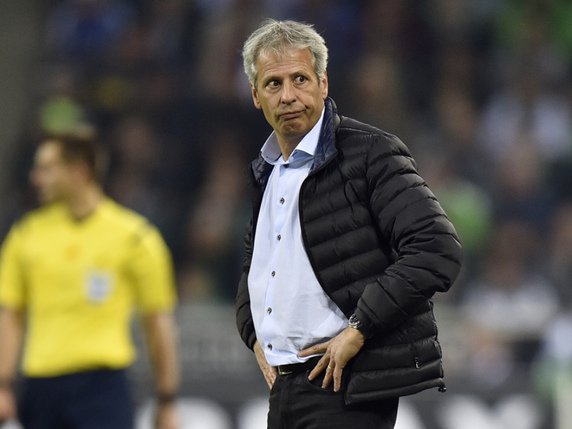 Gladbach were the hot topic around the soccer stat Twittersphere last Friday as they were hammered by generally woeful Hamburg. This dropped the Foals to 4 games, 0 points, 2 goals for, 11 goals against and very much in last place in the Bundesliga. First some context as to why this blew up: Gladbach have had 3 very good seasons in succession despite posting average-to-really bad xG numbers. This chart should help tell the story.
Gladbach were the hot topic around the soccer stat Twittersphere last Friday as they were hammered by generally woeful Hamburg. This dropped the Foals to 4 games, 0 points, 2 goals for, 11 goals against and very much in last place in the Bundesliga. First some context as to why this blew up: Gladbach have had 3 very good seasons in succession despite posting average-to-really bad xG numbers. This chart should help tell the story. 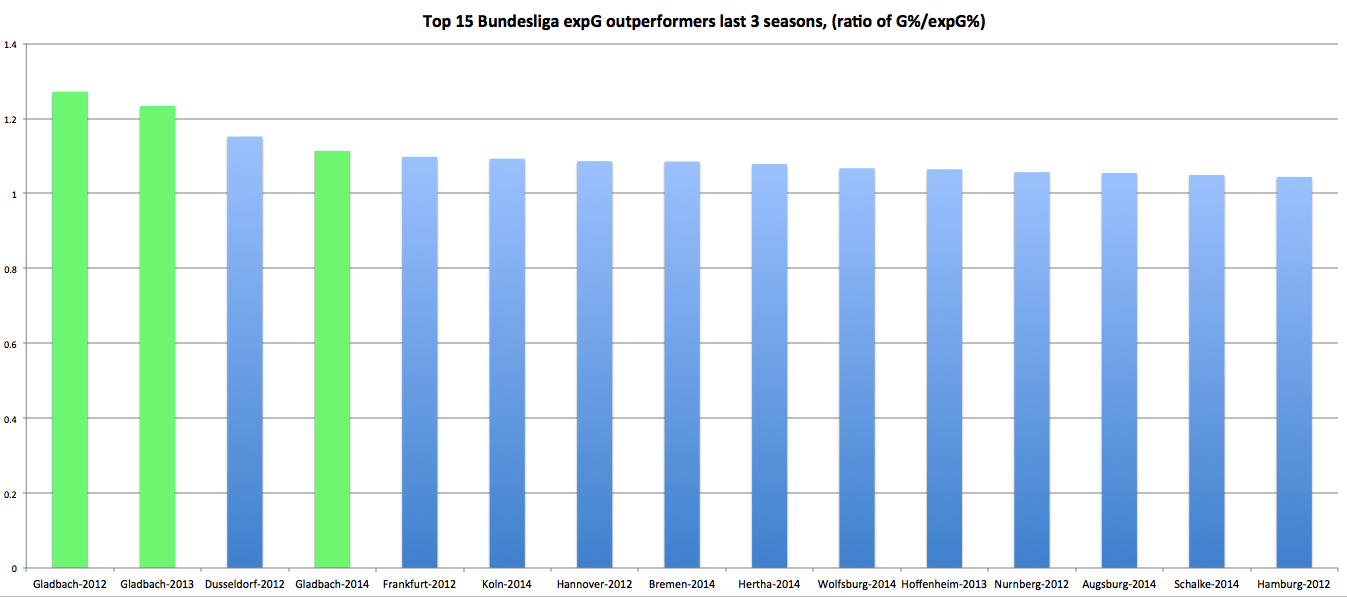 They had 3 of the 4 largest xGR outperformances in the past 3 seasons in Germany. I made the case in this article that they weren’t just a below-average team getting incredibly lucky, they were actually a good team being shorted by a model that didn’t cover what they did very well (mainly pressure opponents while shooting and then last season using a patient, multiple attack to get higher quality shots). The debate on twitter featured two StatsBomb legends coming out and basically saying Gladbach cannot beat xG long-term. Ben Pugsley said “Given enough time….barely any team is special” and Colin Trainor said it would be normal for some team to overperform xG 3 straight years given enough trials, which is true enough. Michael Caley hinted he thought the tactic had been collectively found out and that certain tactics could beat xG for a little bit before falling back to their underlying shot numbers. The 3-year run was over. In general the tone seemed to be, well this team has been lucky for so long, that now it is evening out. The insinuation being their true talent level during past seasons was reflected by the xG models and not the results on the field. I think in general this is a dangerous assumption to make and disagree in this case as well.
They had 3 of the 4 largest xGR outperformances in the past 3 seasons in Germany. I made the case in this article that they weren’t just a below-average team getting incredibly lucky, they were actually a good team being shorted by a model that didn’t cover what they did very well (mainly pressure opponents while shooting and then last season using a patient, multiple attack to get higher quality shots). The debate on twitter featured two StatsBomb legends coming out and basically saying Gladbach cannot beat xG long-term. Ben Pugsley said “Given enough time….barely any team is special” and Colin Trainor said it would be normal for some team to overperform xG 3 straight years given enough trials, which is true enough. Michael Caley hinted he thought the tactic had been collectively found out and that certain tactics could beat xG for a little bit before falling back to their underlying shot numbers. The 3-year run was over. In general the tone seemed to be, well this team has been lucky for so long, that now it is evening out. The insinuation being their true talent level during past seasons was reflected by the xG models and not the results on the field. I think in general this is a dangerous assumption to make and disagree in this case as well. 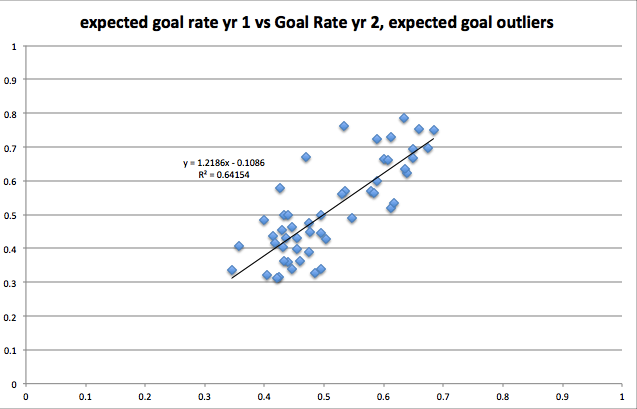
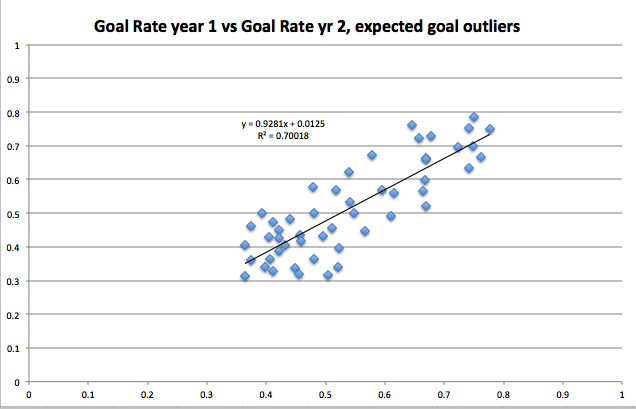 xG hasn't nailed enough outliers for me to be confident in proclaiming teams drastically lucky or unlucky based only on xG rate. I disagree with Colin and Ben, both of whom I have great respect for. I do so knowing I might be wrong and willing to engage with anyone who wants to bring their case in the comments or on twitter. Let me lay my case out first. I don’t think this is a team simply playing as well as they always have been and midnight has finally struck. There are clear indicators that this year, the performance is significantly worse compared to years past. So even though it’s been 5 games*, I took a look at what has changed for Gladbach. *For me, 5 games is plenty to look at trends of how a team possesses and defends passes. Passing stats stabilize a lot quicker than shooting stats, so they can reveal trends quicker than shots/goals. If 1000 player minutes is enough to start making judgement calls on some player shot metrics, team pass metrics have now had nearly 5000 player minutes so should be able to tell us something. Offense
xG hasn't nailed enough outliers for me to be confident in proclaiming teams drastically lucky or unlucky based only on xG rate. I disagree with Colin and Ben, both of whom I have great respect for. I do so knowing I might be wrong and willing to engage with anyone who wants to bring their case in the comments or on twitter. Let me lay my case out first. I don’t think this is a team simply playing as well as they always have been and midnight has finally struck. There are clear indicators that this year, the performance is significantly worse compared to years past. So even though it’s been 5 games*, I took a look at what has changed for Gladbach. *For me, 5 games is plenty to look at trends of how a team possesses and defends passes. Passing stats stabilize a lot quicker than shooting stats, so they can reveal trends quicker than shots/goals. If 1000 player minutes is enough to start making judgement calls on some player shot metrics, team pass metrics have now had nearly 5000 player minutes so should be able to tell us something. Offense  The raw numbers show the offense is clearly worse, but some digging shows things are acutally even worse than a 2.5 drop in shots seems on the surface. Last year they were the best team in the Bundesliga when it came to completing passes in dangerous areas. They were 2 standard deviations above average in deep areas. This year that is not close to the case. Let's see why. They can’t get up the field A league worst 1.2% of Gladbach’s completions come in the Red Zone (within ~20 yards of opp goal). The league average is 3% and the Foals rate would easily be the worst single-season rate in the last 4 seasons in the Bundesliga if they keep it up.
The raw numbers show the offense is clearly worse, but some digging shows things are acutally even worse than a 2.5 drop in shots seems on the surface. Last year they were the best team in the Bundesliga when it came to completing passes in dangerous areas. They were 2 standard deviations above average in deep areas. This year that is not close to the case. Let's see why. They can’t get up the field A league worst 1.2% of Gladbach’s completions come in the Red Zone (within ~20 yards of opp goal). The league average is 3% and the Foals rate would easily be the worst single-season rate in the last 4 seasons in the Bundesliga if they keep it up. 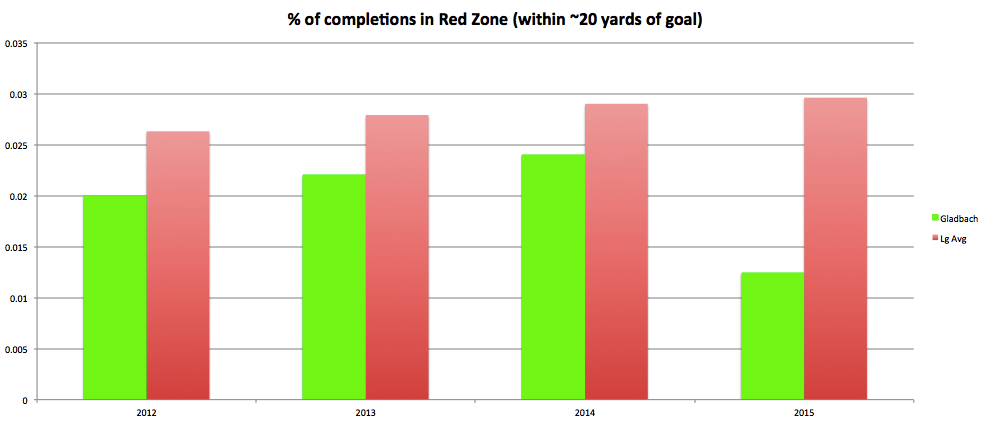 The problem intensified vs Sevilla as they had just 4 of their 353 completions in the Red Zone (1.1%). These completions are coming as a result of much longer passes as well. Last year their average pass distance for a Red Zone completion was the 2nd shortest in the Bundesliga at 14.1 yards, this year so far it has been the 3rd longest (behind only Ingolstadt and Darmstadt) at 21.6 yards. An increase of nearly 7 yards makes a significant difference in the amount of attempts you can expect to complete. So we see the problem, but where does it originate on the pitch? The Dortmund and Sevilla games were the largest hammerings and it seemed they couldn’t get out of their own half so I thought maybe they are just getting stuck close to their own goal. My eye test was not correct (a disappointingly common occurrence): Gladbach have moved into the opposition half slightly more often compared to last year. One possible problem this far from goal is that Xhaka has had to do way more offensive work in total and starts his work closer to goal as Stindl hasn’t quite replaced Kramer’s offensive production. Being so focused on one player to move the ball upfield doesn’t seem like it’s a great tendency for a team to have.
The problem intensified vs Sevilla as they had just 4 of their 353 completions in the Red Zone (1.1%). These completions are coming as a result of much longer passes as well. Last year their average pass distance for a Red Zone completion was the 2nd shortest in the Bundesliga at 14.1 yards, this year so far it has been the 3rd longest (behind only Ingolstadt and Darmstadt) at 21.6 yards. An increase of nearly 7 yards makes a significant difference in the amount of attempts you can expect to complete. So we see the problem, but where does it originate on the pitch? The Dortmund and Sevilla games were the largest hammerings and it seemed they couldn’t get out of their own half so I thought maybe they are just getting stuck close to their own goal. My eye test was not correct (a disappointingly common occurrence): Gladbach have moved into the opposition half slightly more often compared to last year. One possible problem this far from goal is that Xhaka has had to do way more offensive work in total and starts his work closer to goal as Stindl hasn’t quite replaced Kramer’s offensive production. Being so focused on one player to move the ball upfield doesn’t seem like it’s a great tendency for a team to have. 
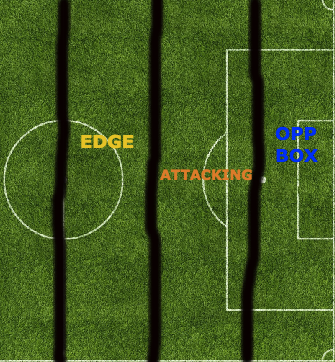
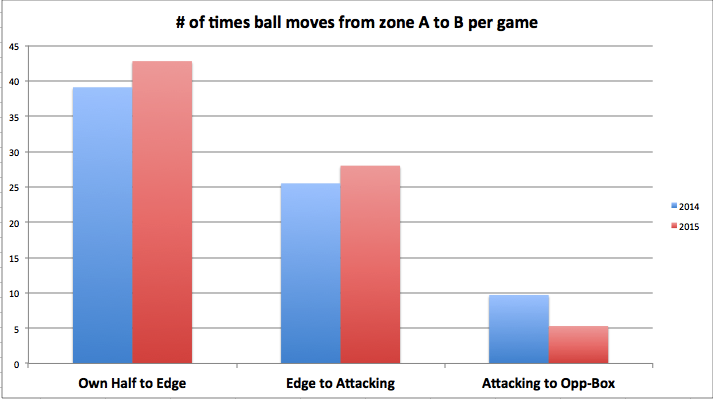 The big problem comes making the final leap, from the “attacking” area into the “opp box” area. Last year nearly twice as many completions were played into this area. It’s not a one-man problem when you see such a huge fall but the Max Kruse-sized hole shows up big-time here.
The big problem comes making the final leap, from the “attacking” area into the “opp box” area. Last year nearly twice as many completions were played into this area. It’s not a one-man problem when you see such a huge fall but the Max Kruse-sized hole shows up big-time here. 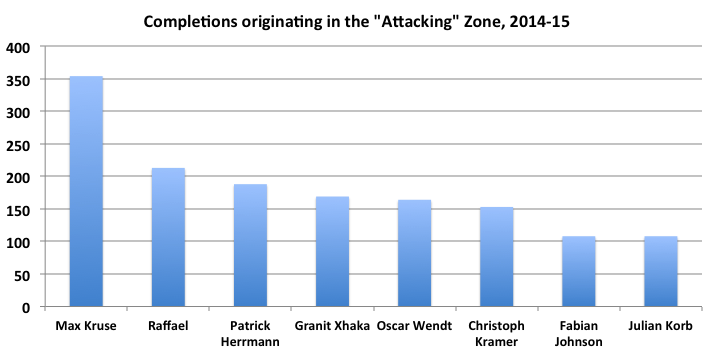 Losing Kruse meant when Gladbach gets deep this year they need to rely on players who were not as good a passer as Kruse was like Hazard, Traore and Hahn (who graded atrociously last season). Now the ball gets close but doesn’t get into a dangerous area as often. No one has increased their load to pick up the slack. When you can’t get the ball deep, you can’t get the number of options needed forward that allows you to have a multifaceted attack. If you want to get open shots playing at a deliberate pace, it’s not going to happen as often with hoofing long balls to a single striker. Gladbach aren’t getting as many different players up the field. Players like Xhaka, Patrick Herrmann, and Raffael are simply possessing the ball much less close to goal.
Losing Kruse meant when Gladbach gets deep this year they need to rely on players who were not as good a passer as Kruse was like Hazard, Traore and Hahn (who graded atrociously last season). Now the ball gets close but doesn’t get into a dangerous area as often. No one has increased their load to pick up the slack. When you can’t get the ball deep, you can’t get the number of options needed forward that allows you to have a multifaceted attack. If you want to get open shots playing at a deliberate pace, it’s not going to happen as often with hoofing long balls to a single striker. Gladbach aren’t getting as many different players up the field. Players like Xhaka, Patrick Herrmann, and Raffael are simply possessing the ball much less close to goal.  attempts here refers to passes Their extremely patient approach (.77 shots per pass attempt inside 20 yards last year) isn’t effective when you can’t get players forward and have the ball for long periods deep in opponent territory. They are now taking 1.13 shots per pass attempt, well above the league average. Defense
attempts here refers to passes Their extremely patient approach (.77 shots per pass attempt inside 20 yards last year) isn’t effective when you can’t get players forward and have the ball for long periods deep in opponent territory. They are now taking 1.13 shots per pass attempt, well above the league average. Defense  Here the raw numbers look essentially similar but the block rate and distance per shot are certainly worrying. So what’s changed on defense? Worse closer to goal In my piece on them last year, I concluded that their strategy of conceding the middle of the pitch and focusing on congesting their own box led to forcing opponents into more harried shots than normal and cutting off passing lanes that could lead to a better shot. This is seen by the “Last 3 Seasons” bars in the chart below. Also in that chart, you see that there is no such effect this season. Essentially the Gladbach defense is basically as good stopping passes near the goal as they are the rest of the field, which makes it hard to conclude they are getting good pressure on shooters.
Here the raw numbers look essentially similar but the block rate and distance per shot are certainly worrying. So what’s changed on defense? Worse closer to goal In my piece on them last year, I concluded that their strategy of conceding the middle of the pitch and focusing on congesting their own box led to forcing opponents into more harried shots than normal and cutting off passing lanes that could lead to a better shot. This is seen by the “Last 3 Seasons” bars in the chart below. Also in that chart, you see that there is no such effect this season. Essentially the Gladbach defense is basically as good stopping passes near the goal as they are the rest of the field, which makes it hard to conclude they are getting good pressure on shooters. 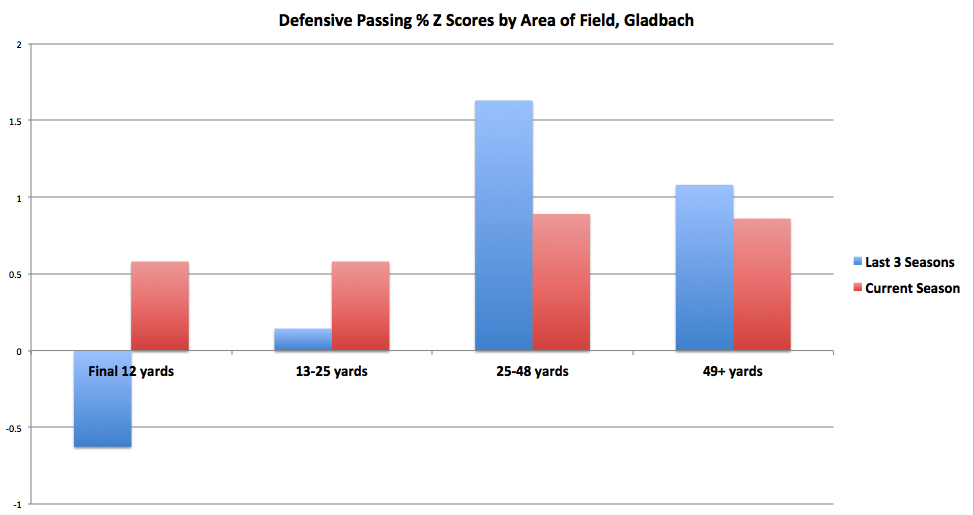 (Final 12 and 13-25 are combined in this season to get a reasonable sample size) The Film Room After inferring decreasing close-to-goal pressure from these passing numbers, I wanted to check with my own eyes. I watched film of every shot from the 5 games so far this season to count Gladbach defenders in the box. I then did the same with the equivalent fixtures from last year (except subbing in Hertha for Hamburg and missing a few shots in the Mainz/Dortmund games, shots that weren’t important enough to make a thorough highlight reel). The clear-cut chances stood out in a big way. Last season in 33 charted open-play, in-box shots, zero came when Gladbach had fewer than 3 defenders inside the box. This season in 45 shots, 6 have already come with fewer than 3 defenders. 3 of those shots have been converted into goals.
(Final 12 and 13-25 are combined in this season to get a reasonable sample size) The Film Room After inferring decreasing close-to-goal pressure from these passing numbers, I wanted to check with my own eyes. I watched film of every shot from the 5 games so far this season to count Gladbach defenders in the box. I then did the same with the equivalent fixtures from last year (except subbing in Hertha for Hamburg and missing a few shots in the Mainz/Dortmund games, shots that weren’t important enough to make a thorough highlight reel). The clear-cut chances stood out in a big way. Last season in 33 charted open-play, in-box shots, zero came when Gladbach had fewer than 3 defenders inside the box. This season in 45 shots, 6 have already come with fewer than 3 defenders. 3 of those shots have been converted into goals. 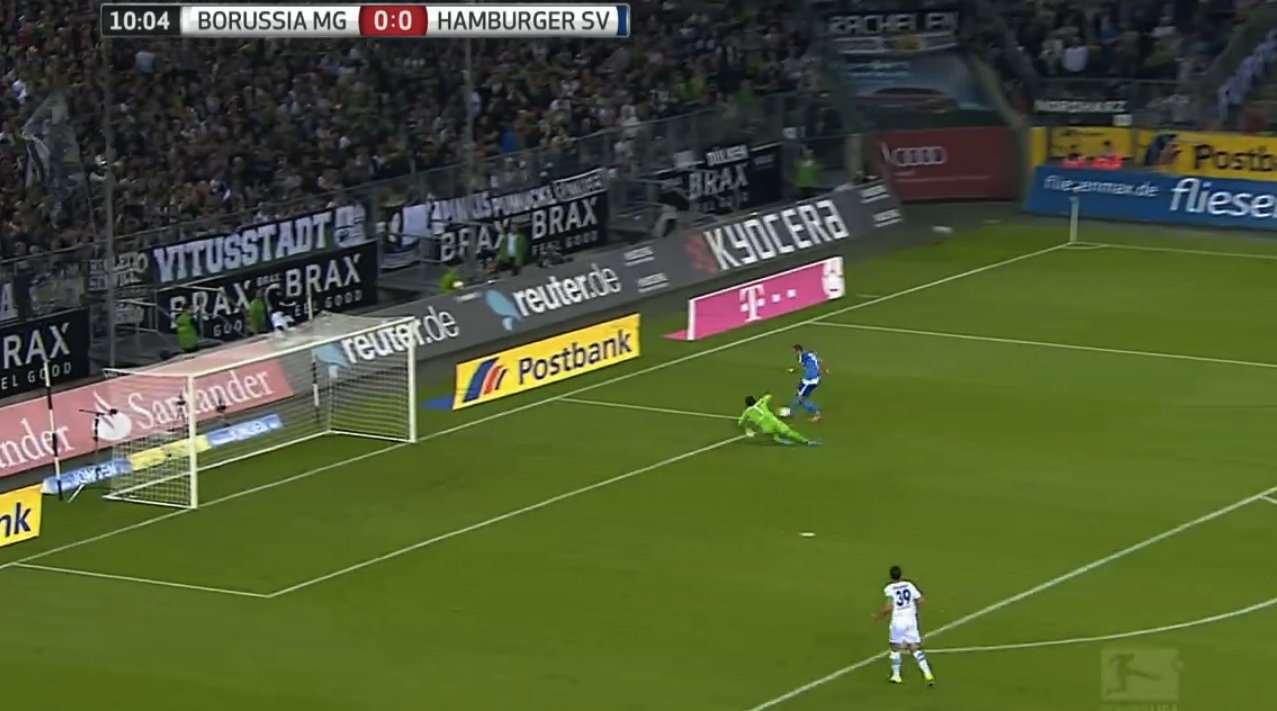
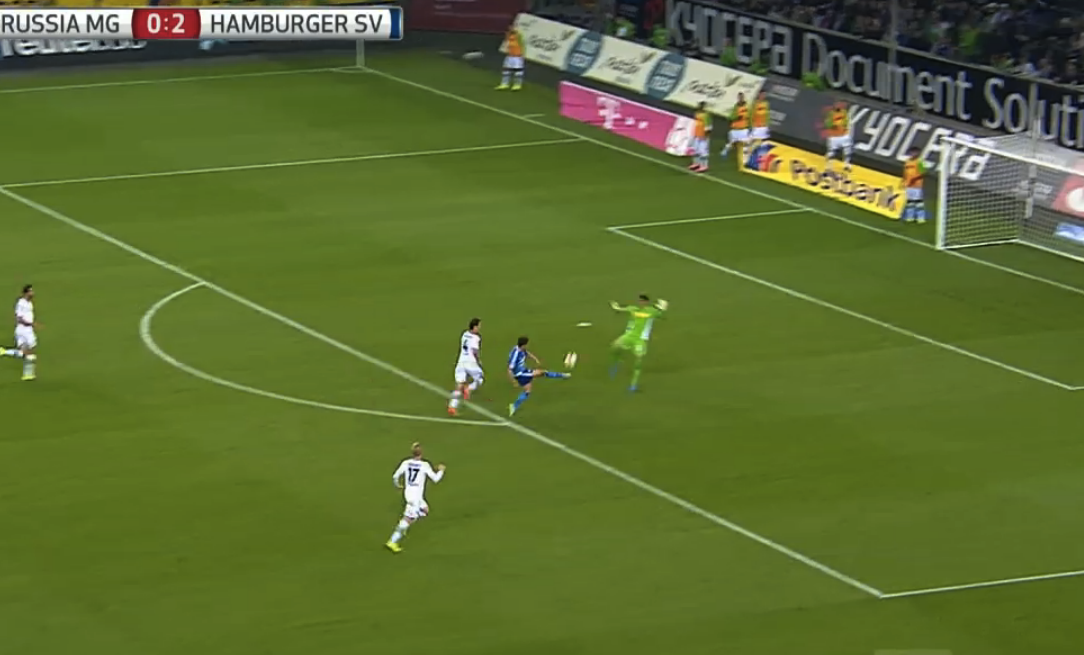
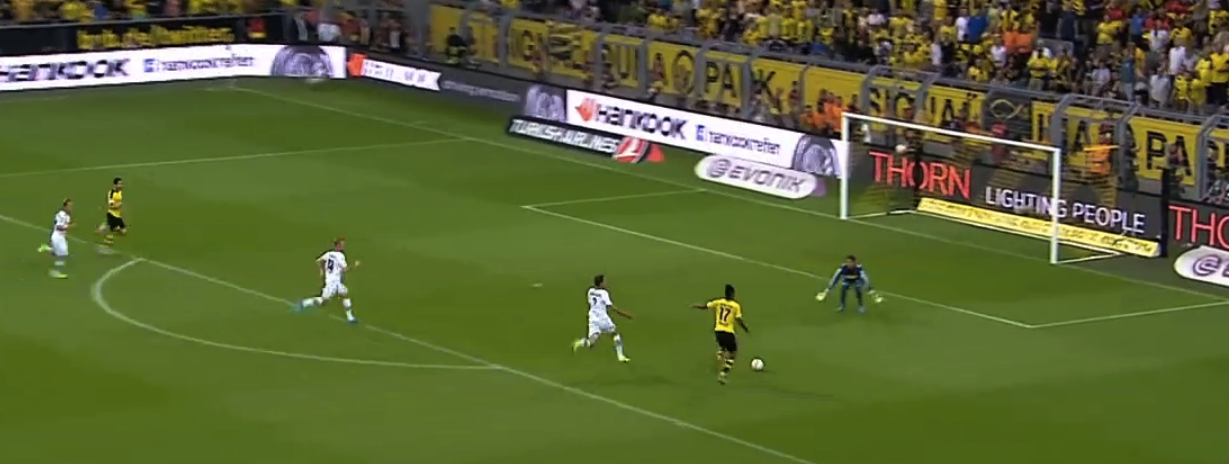
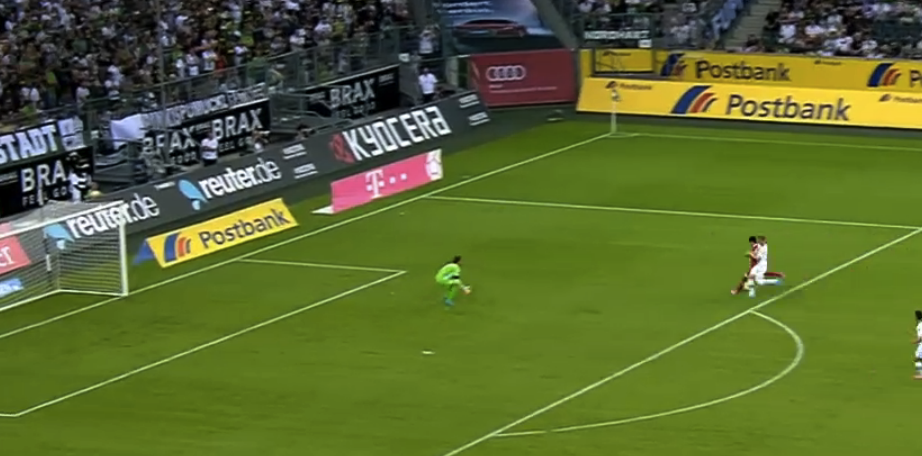
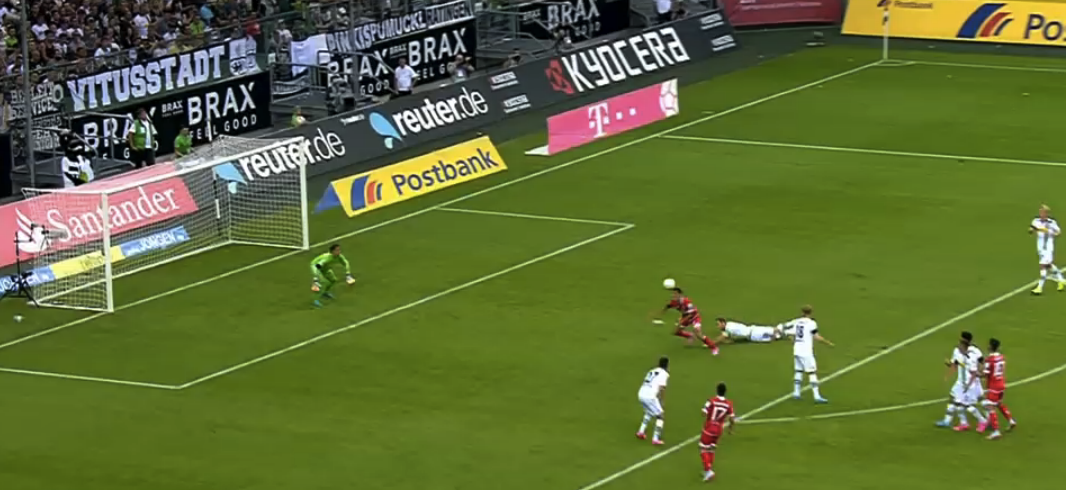
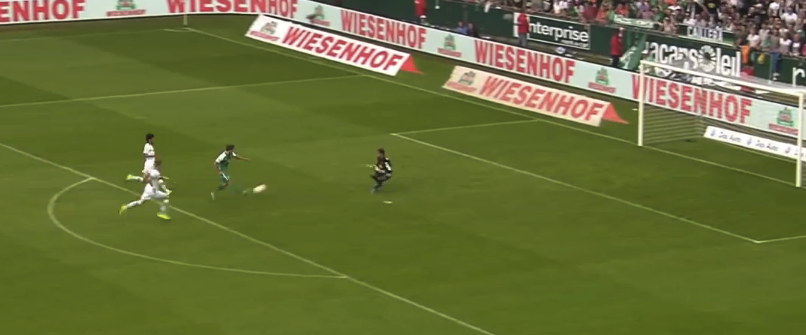 There were zero shots like this last season in the sample. It’s clear that the pressure they have always applied in the final 25 yards, increasing the closer you get to goal, is simply not there so far this season. Teams are passing very well in these areas and have broken through over once a game to take a shot against a basically abandoned box. Those are things that simply never happened last season. Now teams can spend more time picking and choosing their shots, which will certainly increase the chances of a goal. So while their raw shot numbers look about the same, under the surface there are massive problems. There are no individual defensive metrics I feel comfortable enough to divvy out the blame on this one. I will say losing Kramer, a sometime starter on the German national team cannot have helped. Fabian Johnson was injured in the opener and hasn’t returned. Maybe most importantly Martin Stranzl and Alvaro Dominguez, center-backs who started 41 combined games last season have both been out injured with Stranzl just returning for the last game. Replacing them have been mainly kids (19 and 20 year old started at center back vs Dortmund). That’s 4 key players from last years defense who have played 2 combined games this year. I don’t know how much that hurts, but it certainly is imaginable that a system like this is hard to simply plug and play at 4 key defensive positions. Conclusions Maybe Gladbach just didn't have enough talent to withstand the loss of stars like Max Kruse and Christoph Kramer. Maybe those two are way better than most people thought. Maybe this style of football is very precarious and when you downgrade certain parts, it all falls apart more quickly than other, more normal styles. Maybe things will totally turn around over the next two months. Any of those might be true. I can't say for sure, but what I do think is there has been enough in these 5 games to say Gladbach are playing much worse than they did last season. We aren't seeing a continued true talent level from last season with the only change being a correction in the luck category, there has been a significant performance drop. I certainly don't think I have completely explained everything about this drop above, soccer is much too complex a game to have supreme confidence about basically anything, much less something like this after just 5 games. Their performance will certainly change going forward but conclusions about xG in previous seasons should not be drawn from this team right now. They are not doing the things that pointed to xG outperformance. Gladbach were the team that kind of re-focused my energies away from fine-tuning a xG model and more toward looking at how teams pass and play on the entire field. Even if in a few months it turns out that proof emerges that xG was absolutely correct all along, I don't regret shifting focus. I have a clearer picture in my head of how Gladbach from looking deeper into passing stats, and I hope you do as well. Expected goals is a great stat and I love seeing the xG table compared to the regular table, but it's not always infallible and even when it turns out correct it's best use might be as a starting point to further investigation. I feel comfortable saying Gladbach over the past three years have shown us weaknesses in xG models and that's exciting to me. It means we haven't really solved how teams become good. The wide, wonderful world of excel spreadsheets, R consoles, and Tableau maps still has much to reveal.
There were zero shots like this last season in the sample. It’s clear that the pressure they have always applied in the final 25 yards, increasing the closer you get to goal, is simply not there so far this season. Teams are passing very well in these areas and have broken through over once a game to take a shot against a basically abandoned box. Those are things that simply never happened last season. Now teams can spend more time picking and choosing their shots, which will certainly increase the chances of a goal. So while their raw shot numbers look about the same, under the surface there are massive problems. There are no individual defensive metrics I feel comfortable enough to divvy out the blame on this one. I will say losing Kramer, a sometime starter on the German national team cannot have helped. Fabian Johnson was injured in the opener and hasn’t returned. Maybe most importantly Martin Stranzl and Alvaro Dominguez, center-backs who started 41 combined games last season have both been out injured with Stranzl just returning for the last game. Replacing them have been mainly kids (19 and 20 year old started at center back vs Dortmund). That’s 4 key players from last years defense who have played 2 combined games this year. I don’t know how much that hurts, but it certainly is imaginable that a system like this is hard to simply plug and play at 4 key defensive positions. Conclusions Maybe Gladbach just didn't have enough talent to withstand the loss of stars like Max Kruse and Christoph Kramer. Maybe those two are way better than most people thought. Maybe this style of football is very precarious and when you downgrade certain parts, it all falls apart more quickly than other, more normal styles. Maybe things will totally turn around over the next two months. Any of those might be true. I can't say for sure, but what I do think is there has been enough in these 5 games to say Gladbach are playing much worse than they did last season. We aren't seeing a continued true talent level from last season with the only change being a correction in the luck category, there has been a significant performance drop. I certainly don't think I have completely explained everything about this drop above, soccer is much too complex a game to have supreme confidence about basically anything, much less something like this after just 5 games. Their performance will certainly change going forward but conclusions about xG in previous seasons should not be drawn from this team right now. They are not doing the things that pointed to xG outperformance. Gladbach were the team that kind of re-focused my energies away from fine-tuning a xG model and more toward looking at how teams pass and play on the entire field. Even if in a few months it turns out that proof emerges that xG was absolutely correct all along, I don't regret shifting focus. I have a clearer picture in my head of how Gladbach from looking deeper into passing stats, and I hope you do as well. Expected goals is a great stat and I love seeing the xG table compared to the regular table, but it's not always infallible and even when it turns out correct it's best use might be as a starting point to further investigation. I feel comfortable saying Gladbach over the past three years have shown us weaknesses in xG models and that's exciting to me. It means we haven't really solved how teams become good. The wide, wonderful world of excel spreadsheets, R consoles, and Tableau maps still has much to reveal.
What The Hell, Chelsea? Premier League Stat Round Up
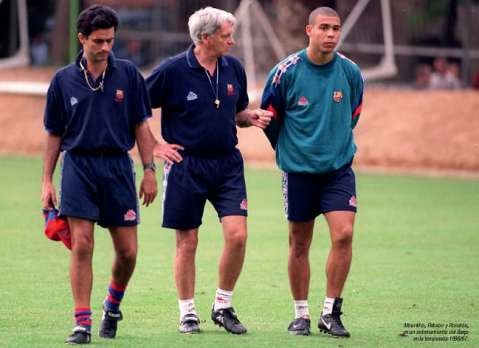
Learning From Early Games and the Shot/Pass Decision
What can we learn in the early days of the season? I'm defining early days as 5 or 10 games here. Pretty much every piece anyone writes is prefaced with "early days" or something similar indicating we should not draw strong conclusions from this data. That is how it should be because things change a lot as the season goes on. I wanted to know just how much can we know and how much do things change.
So I looked at 136 teams from the past 3 seasons in various leagues (Spain, Italy, 2x Germany, France, 2x England) and how they did in the early games compared to how they did the rest of the season in shots, shots on targets, deep completions, and goals. Deep completions are passes completed within an estimated 20 yards of goal (crosses excluded).
I realize I am not the first to do something like this. James Grayson looked at how quickly advanced metrics find their final values, and 11tegen11 took an excellent look at what ratios predict the rest of the season the best. Both are great pieces but hopefully by breaking it down by sides of the ball in-sample vs out-of-sample I can add some to their work.
The first chart is the r squared value of each stat in the first 5 or 10 games against itself the rest of the season. So when you see the 0.28, that means a teams goals scored in their first 5 games has a .28 r squared value when compared with their goals scored per game the rest of the season (33 or 29 games depending on the league).

The most interesting takeaway for me is dangerous completions. It's not that surprising, but teams who are good at getting the ball into dangerous positions identify themselves very quickly. The other interesting thing is the lack of correlation when it comes to defensive events compared to offensive ones. We will come back to this later. Right now we look at how reliable early season rate stats are. It's the same process, the 5 games and 10 games columns are compared to the rest of season games.

And then we see which one is best at predicting goal rate the rest of the season.

Unsurprisingly, we see shots on target is the best at calling the rest of the season. It seems by now we would have left such a seemingly simple stat in the dust, but it lingers on, still effective, like Rafa Marquez playing for Mexico. Expected goals was not included here because I didn't have the data by individual games. Based on Michael Caley's quality research, we can probably assume the most detailed expected goal models would slot in slightly ahead of SoT in these kinds of studies.
So, leaving the rest-of-season rates behind and returning to the reliability of offense vs defense I wondered why is offense so much more reliable than defense when looking at a small sample of games (or really any sized sample)?
To investigate this, I looked at how different attacks were at getting the ball into dangerous positions vs good defenses and bad defenses. I did the same for defenses vs attacks. I wanted to see which side of the ball "controlled" the game. The results were interesting:
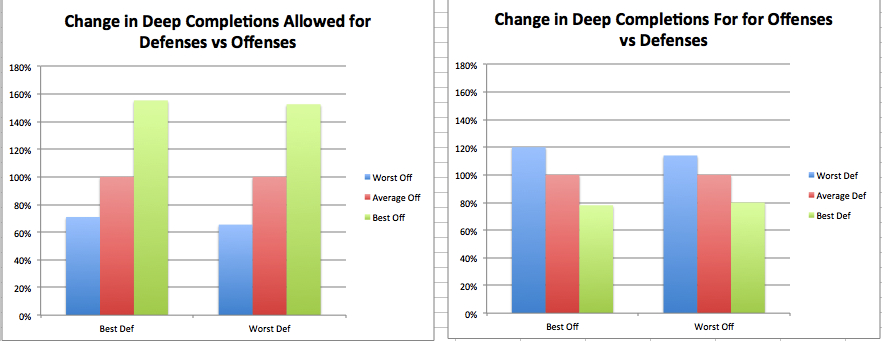
Defenses change from their average a lot more than offenses. A top defense can expect to face 50% more deep completions relative to average when they play a top offense. A top offense sees their deep completion numbers drop only about 20% when they face the top defenses. Offense sees less variation depending on strength of schedule and plays closer to their averages.
Interestingly, the same trend does not hold when looking at shots. Both defenses and offenses swing about 17% from their overall averages when facing the best or worst of their opposite sides. I pondered why this would be, why do defenses allow 50% more deep completions when facing a great offense but only 20% more shots? It has to do with the fact that the best teams generally average a lower shot/deep completion ratio. The best offenses can possess the ball and set up shop with more players in the attacking third. More options to pass to means less urgency to fire immediately and more patience to wait and pick out a better shot. If you have the potential of passing to a teammate to take a clean look from 12 yards, you will be much less likely to try a harried shot through traffic from 15 yards. This shot/deep completion ratio does not drastically change depending on the opponent:
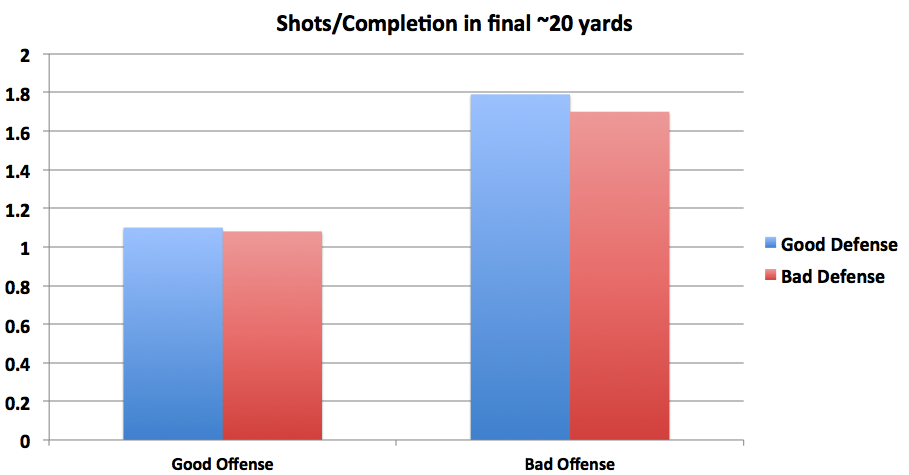
I wanted to look further at this total shot/deep completion rate so split each teams offensive and defensive shot/deep completion rates into halves of seasons.
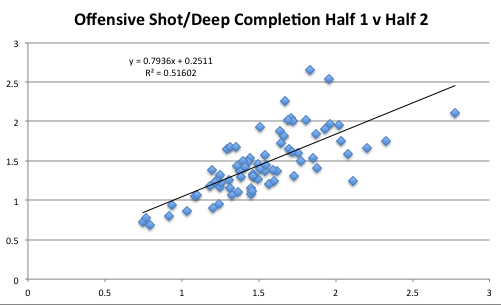
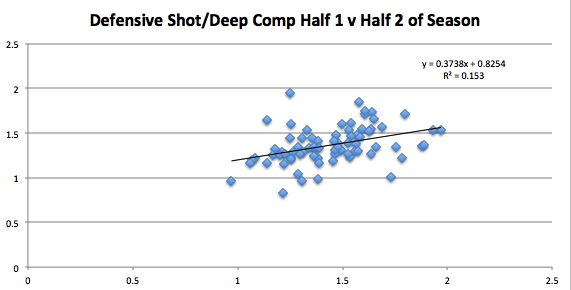
Offenses have more control over their shot/deep completion rate. Defenses can do all they want and affect things some but how often a team shoots per pass in deep areas seems to be more in the hands of the offense.
Wrapping up
-If you have to guess before a game about who is going to get into dangerous position more often, base it on how often the offenses get into dangerous positions. In general, they will dictate where the ball spends most of its time.
-The best offensive teams generally pass a lot more often when within 20 yards of goal, this is because they have more options available so any given shot is not as valuable as it is for teams with bad offenses. In general it's a better decision for Jermaine Defoe at Sunderland to launch an 18-yard shot than it is for Marco Reus at Dortmund even if the expected conversion % is the exact same. Sunderland will probably not get the ball into a better spot, while Dortmund are more likely to. This decision seems to be mainly made by the offense and not the defense.
There is tons of work to do here. Something Paul Riley wrote I believe has lots of relevance on this issue. If you have more people in the box on offense (or fewer on defense) it follows that you will be passing more and the chances you get will be cleaner. I think the pass/shot decision is a ripe area for research and will be able to tell you a lot about a team or maybe way down the road, players. The ratio of attackers in the area vs defenders in the area for each goal/shot/pass seems like a great piece of information to add to this still-blurry picture.
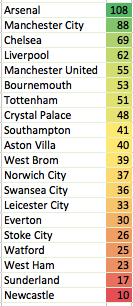
Deep Completion Table
We've talked about it enough so let's look at a table. It's good news for Bournemouth, who have been very impressive on the attack so far.
Passing Map Time
This week it is Liverpool who you can play around with and see how they move the ball. It is preset to show the surprisingly low # of completions from Henderson to Milner in their nearly 2 games together.
This link takes you to a separate workbook page
There are multiple parameters that you can tweak: type of pass, game, time in game, origin, distance, result, danger level, passer identity, receiver identity and more. So particularly if you're a Liverpool fan, take a look under the hood and see what passing styles are driving their play.

An interesting, if slightly unfair, comparison is how Liverpool gets the ball to its main goal threat in dangerous positions vs Bayern to theirs. Liverpool deep completions to Benteke:
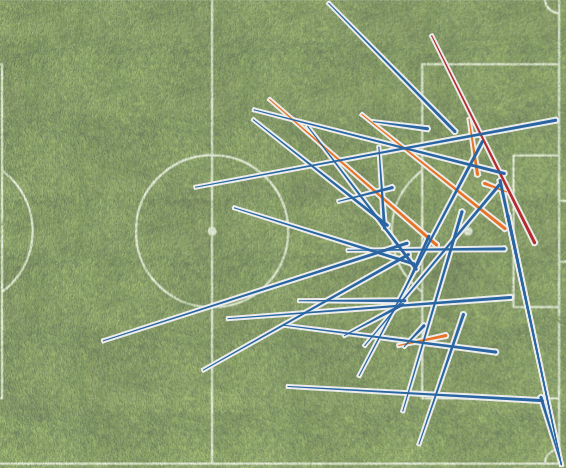
vs Bayern's deep completions (their map can be found here) to Muller/Lewandowski
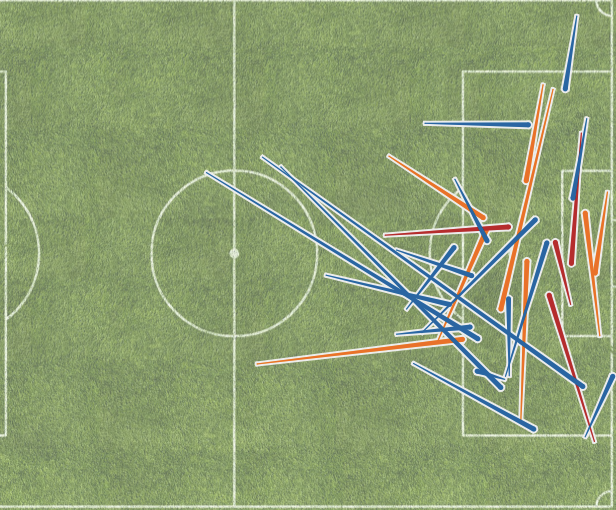
The average completion to Benteke travels 28 yards while Muller and Lewandowski are receiving passes from 21.6 yards away. Benteke also accounts for 34% of all Liverpool receptions within 25 yards of goal, while Muller and Lewandowski combined are at 43% for Bayern, showing they simply have more options in attack.
Hope you enjoyed and would love to hear your thoughts in the comments or on twitter @Saturdayoncouch.
Randomness And The Fog Of Goals
Short termism is rife in football coverage these days. From the insatiable desire to learn 5 things from each match day to the pendulum swing in Falcao’s perceived talent level between last summer and this. It’s common to hear strikers’ peaks and troughs talked about in terms of confidence, hunger and desire, as though each change in output is the result of some tweak in the internal machinery of the player’s mentality and training. But how much of this is true and how much can be attributed to statistical noise? Take these three players, for instance. Goal-scoring in 6 consecutive season adjusted for minutes played. Who do you think they are? Which player is the best? 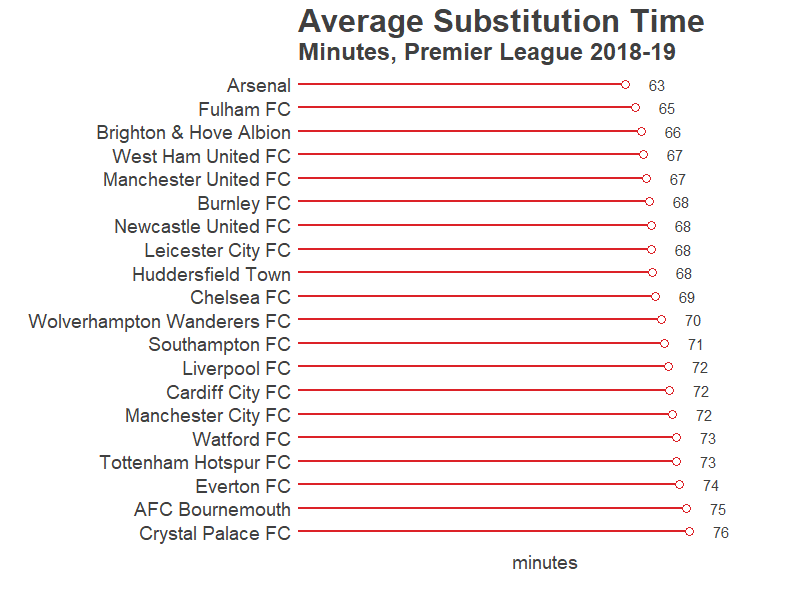 Of course, as you may have guessed from the article so far, this is a trick question. They are, in fact, the same player (sort of). These charts are the results of three simulations using the same starting conditions. These three 'players' are taking the same number of shots (138) with each shot being given the same probability of being scored (14%) for each of the 18 seasons shown. With this in mind it’s easy to see how narratives can form from little more than random variation. Is player 1 in decline? Is player 2 more consistent than the other players? Of course, it’s easy for me to be smug having shown just one comparison. Below is a gif cycling through more simulations using the same starting conditions as above.
Of course, as you may have guessed from the article so far, this is a trick question. They are, in fact, the same player (sort of). These charts are the results of three simulations using the same starting conditions. These three 'players' are taking the same number of shots (138) with each shot being given the same probability of being scored (14%) for each of the 18 seasons shown. With this in mind it’s easy to see how narratives can form from little more than random variation. Is player 1 in decline? Is player 2 more consistent than the other players? Of course, it’s easy for me to be smug having shown just one comparison. Below is a gif cycling through more simulations using the same starting conditions as above. 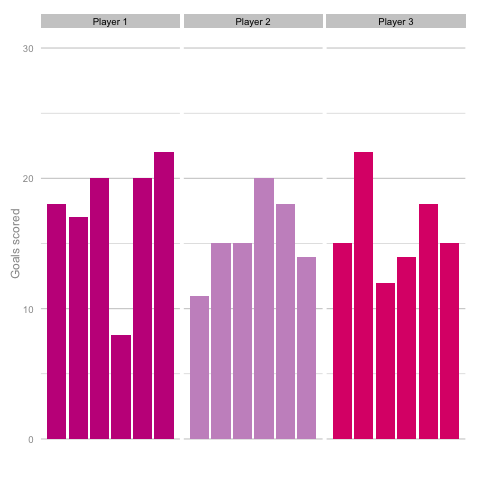 Unsurprisingly, most simulations don’t seem to suggest a wild difference between each player’s output over the 6 simulated seasons. Nonetheless, it can be tempting to see patterns in individual frames. Perhaps a player looks like they’re steadily improving, for instance. Maybe one player looks consistent, while the others are unpredictable or mercurial. If we were to add in real world events around these virtual players, and it's easy to see how we can be tricked by randomness. That freak 25 goal season could start to look like the new manager’s stroke of genius. Or maybe that slump to 10 goals coincides suspiciously with some off-field revelations in the tabloids. In a slightly different example, what if the players were performing differently? How easily could you tell? The following set of simulations shows the three players taking a different number of shots, (though each individual shot continues to have the same probability of being scored). In this example, the players are taking 70, 100 and 130 shots. Over a 2000 minute season (22.2 90s), this corresponds to a difference of 1.35 shots p90 (or, if you prefer, roughly one 14/15 Ashley Young) and a difference of 4.2 expected goals (30 shots * 14% chance of scoring each).
Unsurprisingly, most simulations don’t seem to suggest a wild difference between each player’s output over the 6 simulated seasons. Nonetheless, it can be tempting to see patterns in individual frames. Perhaps a player looks like they’re steadily improving, for instance. Maybe one player looks consistent, while the others are unpredictable or mercurial. If we were to add in real world events around these virtual players, and it's easy to see how we can be tricked by randomness. That freak 25 goal season could start to look like the new manager’s stroke of genius. Or maybe that slump to 10 goals coincides suspiciously with some off-field revelations in the tabloids. In a slightly different example, what if the players were performing differently? How easily could you tell? The following set of simulations shows the three players taking a different number of shots, (though each individual shot continues to have the same probability of being scored). In this example, the players are taking 70, 100 and 130 shots. Over a 2000 minute season (22.2 90s), this corresponds to a difference of 1.35 shots p90 (or, if you prefer, roughly one 14/15 Ashley Young) and a difference of 4.2 expected goals (30 shots * 14% chance of scoring each). 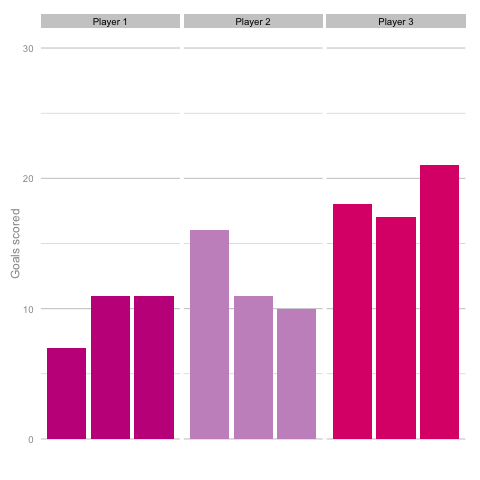 It’s pretty easy to see which player is which after a few frames. Nonetheless, we can also see how this difference in players can be exaggerated or eliminated by nothing more than variance. Moreover, each frame is a top down look at 9 seasons of (simulated) data, with no extra adjustment needed for minutes played, injuries, tactics or any of the other myriad factors that go into a real season of football. The 'true' difference between players in an individual simulation can be masked by randomness. The final gif shown is a combination of the previous two. It shows 10 frames: half of them have identical starting conditions and the other half are graded as in the previous example. Can you tell which is which?*
It’s pretty easy to see which player is which after a few frames. Nonetheless, we can also see how this difference in players can be exaggerated or eliminated by nothing more than variance. Moreover, each frame is a top down look at 9 seasons of (simulated) data, with no extra adjustment needed for minutes played, injuries, tactics or any of the other myriad factors that go into a real season of football. The 'true' difference between players in an individual simulation can be masked by randomness. The final gif shown is a combination of the previous two. It shows 10 frames: half of them have identical starting conditions and the other half are graded as in the previous example. Can you tell which is which?* 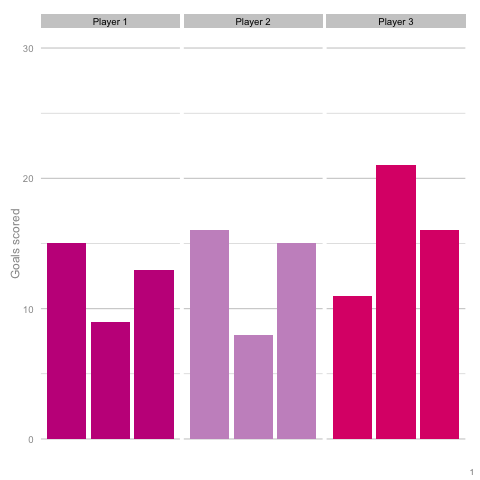 In the real world, clubs can’t just run another simulation to get a better idea of who’s actually good. Randomness and probability are really hard; real world events are unpredictable and irregular. This is where analytics is useful, from fans and media outlets, to coaches and managers. By creating models and looking at the underlying numbers, we can identify where random variation is strongest, react and move to make fewer mistakes or eliminate rash decisions as a result. For instance, in this example, moving from goals to a closer look at the shots numbers would give a clearer idea of whether the differences in these players' performance was likely to be repeatable. We can then use models and perform statistical tests to get a better idea of how likely it is that one player is superior to another. For clubs, this can be used as a complement to more traditional recruitment techniques to avoid costly overpays on over performing players, or to find bargains. For fans, knowledge of such numbers can help avoid results-driven hysteria and see that it's more likely that Arsenal are still quite good (but perhaps unlucky) and that Chelsea really have been that bad. Credit to NY Times (http://www.nytimes.com/2014/05/02/upshot/how-not-to-be-misled-by-the-jobs-report.html?_r=0) and Lena Groeger's talk (https://www.youtube.com/watch?v=zd0YQAgu3dI) for the dataviz ideas that this article shamelessly appropriates. *Seasons with the same starting conditions: 1, 2, 3, 8 and 10 (number shown in bottom right corner)
In the real world, clubs can’t just run another simulation to get a better idea of who’s actually good. Randomness and probability are really hard; real world events are unpredictable and irregular. This is where analytics is useful, from fans and media outlets, to coaches and managers. By creating models and looking at the underlying numbers, we can identify where random variation is strongest, react and move to make fewer mistakes or eliminate rash decisions as a result. For instance, in this example, moving from goals to a closer look at the shots numbers would give a clearer idea of whether the differences in these players' performance was likely to be repeatable. We can then use models and perform statistical tests to get a better idea of how likely it is that one player is superior to another. For clubs, this can be used as a complement to more traditional recruitment techniques to avoid costly overpays on over performing players, or to find bargains. For fans, knowledge of such numbers can help avoid results-driven hysteria and see that it's more likely that Arsenal are still quite good (but perhaps unlucky) and that Chelsea really have been that bad. Credit to NY Times (http://www.nytimes.com/2014/05/02/upshot/how-not-to-be-misled-by-the-jobs-report.html?_r=0) and Lena Groeger's talk (https://www.youtube.com/watch?v=zd0YQAgu3dI) for the dataviz ideas that this article shamelessly appropriates. *Seasons with the same starting conditions: 1, 2, 3, 8 and 10 (number shown in bottom right corner)
Podcast September '15: Early Season Thoughts And Transfer Musings
Back with another podcast! First pod of the season sees a look at the early numbers, both the good and the bad followed by a look at some of the key transfers, those that happened and some that didn't. If you are an iTunes user (or want to subscribe to the pod via a different player) this link should help: Stats Bomb podcast ...and the pod is downloadable directly from Soundcloud or via that previous link for anyone still struggling, as I have, with iTunes. Plenty of ways to listen, stats fans! Hosted by James Yorke (@jair1970) and Benjamin Pugsley (@benjaminpugsley) 
Bayern v Bayer: Act One in the Bundesliga
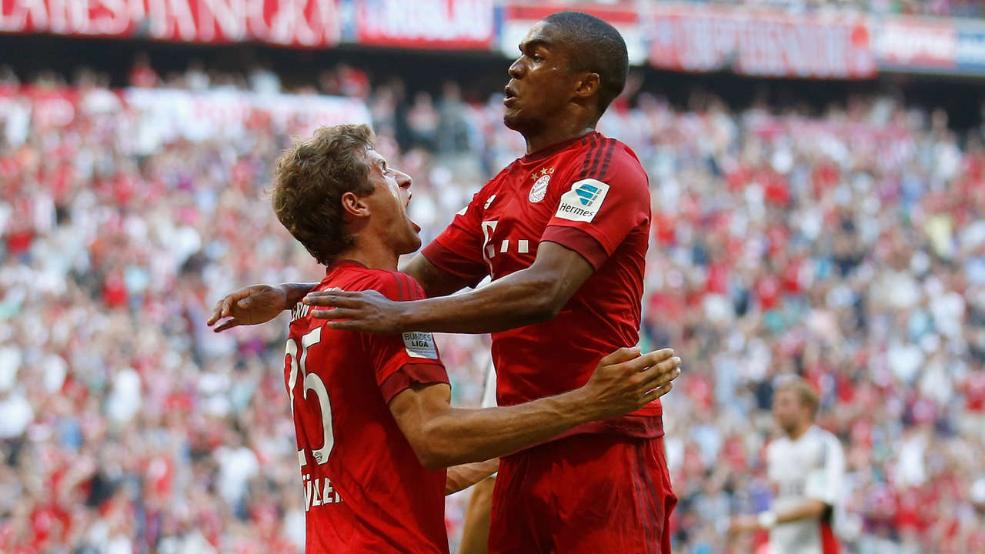 First, more on Maurizio Sarri, whose quotes I highlighted last week. He studied statistics at university and collects data on every team he coaches. He is one of us stat-guys according to a friendly translation of this Sky article. His key stats: how high his defensive line is, how often his defenders pass the ball to playmakers, how often midfielders play vertical completions compared to how often they lose the ball, and then he lets his forwards roam free ("like a baby" in what is a serious head-scratcher of an Italian saying). If interested you can read a preseason profile of Sarri and Napoli in English here. Once again, go Sarri and go Napoli, and don't concede 2 in 2 minutes again. The big story in Europe this week was the clash of two of Europe's best and toughest teams at the Allianz Arena as Bayern hosted Leverkusen. It was an entertaining and fascinating game that wound up as a solid 3-0 win for Bayern. Let's take a look. If you are reading this on mobile, I'd advise you to read the words now, then come back later on a computer because you won't be able to use the Tableau tools near the bottom of the piece on your phone. Leverkusen press doesn’t get to Bayern Leverkusen eased off their frenetic pressure a bit at the end of last season, seeing opponents complete well over 70% of their passes after nearing the 60% mark in November. In their first 4 games this year, they were back at full speed: 56% passing from Hoffenheim, 62% from Hannover, and a steamrolling of Lazio. They tried to hassle Bayern with that same high pressure, but the champions coped magnificently. Bayern O v Leverkusen D is the red line way to the right here, with Leverkusen's first two games well to the left. This shows Bayern were barely hassled in their own half.
First, more on Maurizio Sarri, whose quotes I highlighted last week. He studied statistics at university and collects data on every team he coaches. He is one of us stat-guys according to a friendly translation of this Sky article. His key stats: how high his defensive line is, how often his defenders pass the ball to playmakers, how often midfielders play vertical completions compared to how often they lose the ball, and then he lets his forwards roam free ("like a baby" in what is a serious head-scratcher of an Italian saying). If interested you can read a preseason profile of Sarri and Napoli in English here. Once again, go Sarri and go Napoli, and don't concede 2 in 2 minutes again. The big story in Europe this week was the clash of two of Europe's best and toughest teams at the Allianz Arena as Bayern hosted Leverkusen. It was an entertaining and fascinating game that wound up as a solid 3-0 win for Bayern. Let's take a look. If you are reading this on mobile, I'd advise you to read the words now, then come back later on a computer because you won't be able to use the Tableau tools near the bottom of the piece on your phone. Leverkusen press doesn’t get to Bayern Leverkusen eased off their frenetic pressure a bit at the end of last season, seeing opponents complete well over 70% of their passes after nearing the 60% mark in November. In their first 4 games this year, they were back at full speed: 56% passing from Hoffenheim, 62% from Hannover, and a steamrolling of Lazio. They tried to hassle Bayern with that same high pressure, but the champions coped magnificently. Bayern O v Leverkusen D is the red line way to the right here, with Leverkusen's first two games well to the left. This shows Bayern were barely hassled in their own half. 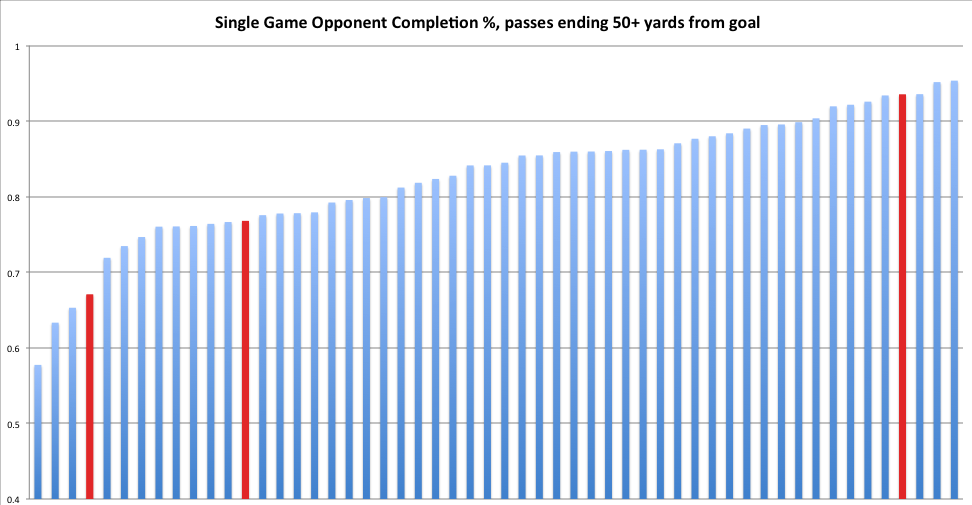 Leverkusen’s press tries to keep you from stopping and catching your breath. Only 25% of passes went backwards against them in the first two games (only Schalke had a lower rate, thanks to facing Darmstadt). You also generally can’t go over the top of the defense, no one was tougher to complete 20+ yard forward passes against (24% completion rate coming into Saturday). So you wind up having to struggle forward using short passes with red shirts buzzing everywhere. Bayern both went over the top and found space to breathe, neutralizing the press and dominating the game. They played a typically-Bayern 36% of their passes backwards and went 37/72 on passes that moved them 20+ yards closer to goal. That percentage is one of the highest single-game totals of the young season in Germany. These long balls came mainly from David Alaba and Xabi Alonso who played in central defense and distributed magnificently.
Leverkusen’s press tries to keep you from stopping and catching your breath. Only 25% of passes went backwards against them in the first two games (only Schalke had a lower rate, thanks to facing Darmstadt). You also generally can’t go over the top of the defense, no one was tougher to complete 20+ yard forward passes against (24% completion rate coming into Saturday). So you wind up having to struggle forward using short passes with red shirts buzzing everywhere. Bayern both went over the top and found space to breathe, neutralizing the press and dominating the game. They played a typically-Bayern 36% of their passes backwards and went 37/72 on passes that moved them 20+ yards closer to goal. That percentage is one of the highest single-game totals of the young season in Germany. These long balls came mainly from David Alaba and Xabi Alonso who played in central defense and distributed magnificently. 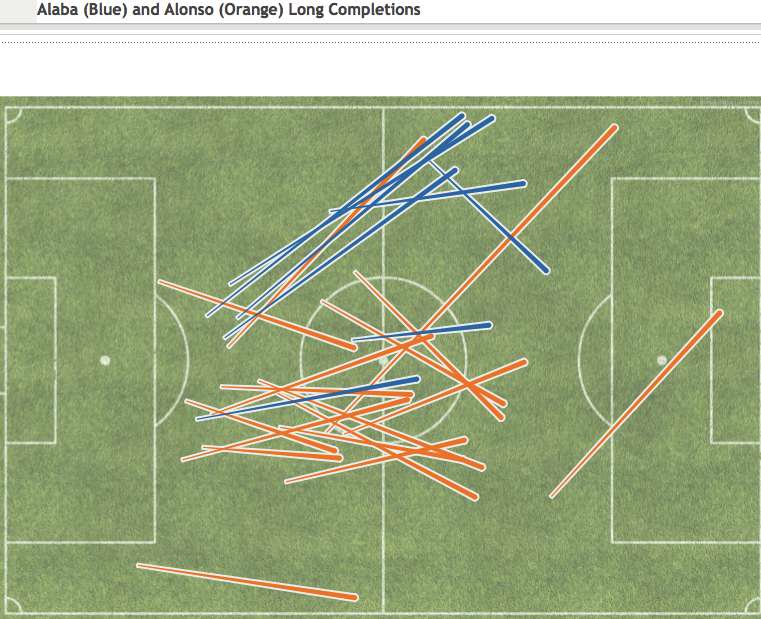 Alonso mainly found Muller and Lewandowski toward the center of the pitch and Alaba found Costa down the left but it was Alonso who stepped up and found Costa with the long ball that led to the opening goal.
Alonso mainly found Muller and Lewandowski toward the center of the pitch and Alaba found Costa down the left but it was Alonso who stepped up and found Costa with the long ball that led to the opening goal.
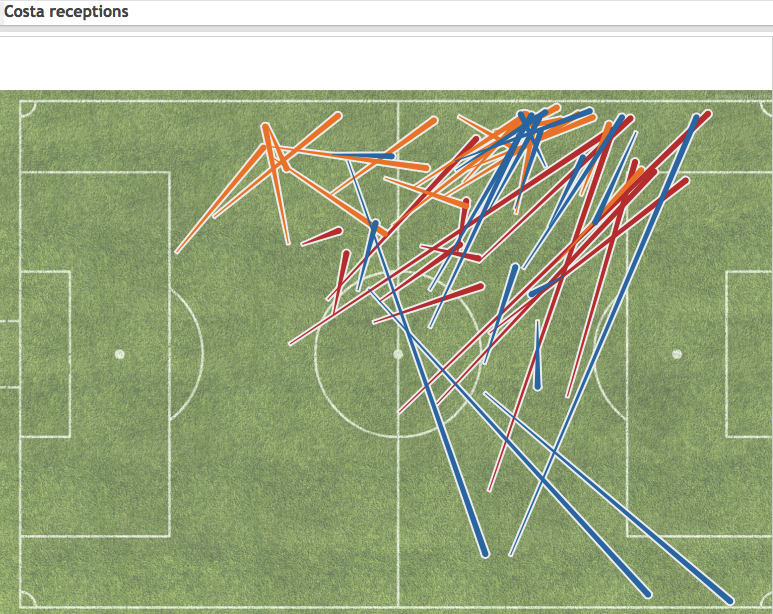
 Costa’s speed and dribbling ability coupled with the attention teams have to pay to the middle of the pitch have allowed him to burst past his man and play balls across. With a host of incompletions have come a lot of very dangerous completions (through all 3 games, red is goal, green is shot, blue is regular completion):
Costa’s speed and dribbling ability coupled with the attention teams have to pay to the middle of the pitch have allowed him to burst past his man and play balls across. With a host of incompletions have come a lot of very dangerous completions (through all 3 games, red is goal, green is shot, blue is regular completion): 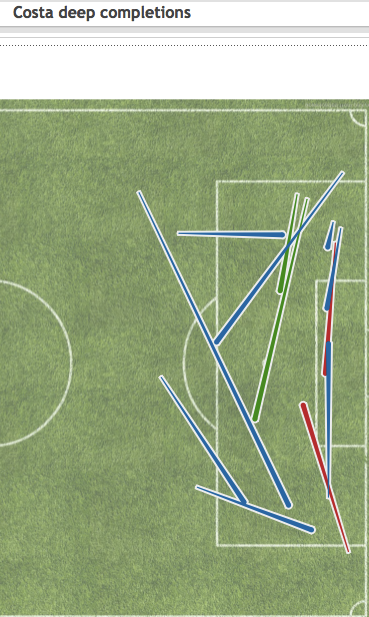 It's not a one-sided attack either, Arjen Robben is on the right and began to do damage this weekend. This was more of a masterpiece from Bayern than anything Leverkusen did wrong. If it takes David Alaba and Xabi Alonso at center back and Arjen Robben and Douglas Costa on the wings to break your press and even then you only allow 1 open-play goal, that’s a sign of a great defense. Bayern had 14 shots to Leverkusen's 10 so you can imagine a day where Leverkusen won, but the better side won this day and won in a repeatable way that showed the gap in quality between #1 and #3. The other side Part of what makes Leverkusen fun and distinctive to watch is their nonstop pace whether it be on defense or offense but at times their offense looks so chaotic it’s hard not to wonder if a little patience might help. Their defense is outstanding and has been on a Bayern and Dortmund level so far, limiting teams to just 18 completions within 20 yards of goal. When you’ve played Bayern and are still at the top, there’s nothing wrong on that side of the ball. It’s their offense that isn’t quite up to the elite level this year or last as the chart shows.
It's not a one-sided attack either, Arjen Robben is on the right and began to do damage this weekend. This was more of a masterpiece from Bayern than anything Leverkusen did wrong. If it takes David Alaba and Xabi Alonso at center back and Arjen Robben and Douglas Costa on the wings to break your press and even then you only allow 1 open-play goal, that’s a sign of a great defense. Bayern had 14 shots to Leverkusen's 10 so you can imagine a day where Leverkusen won, but the better side won this day and won in a repeatable way that showed the gap in quality between #1 and #3. The other side Part of what makes Leverkusen fun and distinctive to watch is their nonstop pace whether it be on defense or offense but at times their offense looks so chaotic it’s hard not to wonder if a little patience might help. Their defense is outstanding and has been on a Bayern and Dortmund level so far, limiting teams to just 18 completions within 20 yards of goal. When you’ve played Bayern and are still at the top, there’s nothing wrong on that side of the ball. It’s their offense that isn’t quite up to the elite level this year or last as the chart shows.  The offense is good, but hasn’t been able get into prime positions quite enough for them to leap completely into the European elite. One thing it looks like Schmidt is trying this season to fix that is throwing the fullbacks forward in attack more: Wendell and Hilbert are completing just over 10 passes per game within 30 yards of goal, up significantly from 6.9 last season. I don’t want to sound negative here: Leverkusen have been great so far and are a comfortable #3 in Germany, but the next step on the way up is moving the ball a bit deeper without compromising the ferocious defense. They lost away to Bayern, no big deal. They can take solace in their hammering of Lazio to make the UCL. That leaves everything on the table this season for Leverkusen. Streak Stats -Darmstadt do not have a streak of 10 consecutive completions on the season. Wolfsburg, Gladbach, Dortmund and Bayern all have 60+ such streaks. -Bayern have allowed just 5 streaks of 10 consecutive completions. Gladbach, Hertha and Mainz have allowed 40+ such streaks. Describing the Bundesliga I will put my money where my mouth is and describe the first three games using a few metrics, mainly deep completions. Now, a few caveats. First, read this great piece at the 2+2=11 blog about how teams with lots of dangerous passes generally have possessions where they move the ball about racking up big shots. Ideally per-possession deep completions would be used here, but I haven't reached that skill level yet when wrangling with the data. My cutoff level for a dangerous pass is closer to the goal than Will's so it's not as big of a problem for me as teams don't often just pass the ball around within 20 yards of goal, but the effect is certainly still here. The x axis at the bottom is basically weighted deep completion rate, so I can count a complete pass 5 yards from goal as more valuable than one 25 yards from goal. The y axis is shots allowed per deep completion. Don't get too wrapped up in the exact numbers, the differences between teams are more revealing. Defensive chart here:
The offense is good, but hasn’t been able get into prime positions quite enough for them to leap completely into the European elite. One thing it looks like Schmidt is trying this season to fix that is throwing the fullbacks forward in attack more: Wendell and Hilbert are completing just over 10 passes per game within 30 yards of goal, up significantly from 6.9 last season. I don’t want to sound negative here: Leverkusen have been great so far and are a comfortable #3 in Germany, but the next step on the way up is moving the ball a bit deeper without compromising the ferocious defense. They lost away to Bayern, no big deal. They can take solace in their hammering of Lazio to make the UCL. That leaves everything on the table this season for Leverkusen. Streak Stats -Darmstadt do not have a streak of 10 consecutive completions on the season. Wolfsburg, Gladbach, Dortmund and Bayern all have 60+ such streaks. -Bayern have allowed just 5 streaks of 10 consecutive completions. Gladbach, Hertha and Mainz have allowed 40+ such streaks. Describing the Bundesliga I will put my money where my mouth is and describe the first three games using a few metrics, mainly deep completions. Now, a few caveats. First, read this great piece at the 2+2=11 blog about how teams with lots of dangerous passes generally have possessions where they move the ball about racking up big shots. Ideally per-possession deep completions would be used here, but I haven't reached that skill level yet when wrangling with the data. My cutoff level for a dangerous pass is closer to the goal than Will's so it's not as big of a problem for me as teams don't often just pass the ball around within 20 yards of goal, but the effect is certainly still here. The x axis at the bottom is basically weighted deep completion rate, so I can count a complete pass 5 yards from goal as more valuable than one 25 yards from goal. The y axis is shots allowed per deep completion. Don't get too wrapped up in the exact numbers, the differences between teams are more revealing. Defensive chart here:  For Tableau click here. The trend is when you face fewer deep passes, you tend to give up more shots per completion. When teams face Bayern, they aren't mucking about when they get into the box, they are firing a shot (see the streak stats above for how hard it is to string passes together). That makes Dortmund's early-season performance notable for how it bucks the trend. They've allowed just 12 shots (though of much higher quality), basically half as many as Bayern when facing essentially the same amount of dangerous passes. It's been 3 games and Bayern have faced tougher competition so for now it's just something to keep an eye on going forward. The offensive chart:
For Tableau click here. The trend is when you face fewer deep passes, you tend to give up more shots per completion. When teams face Bayern, they aren't mucking about when they get into the box, they are firing a shot (see the streak stats above for how hard it is to string passes together). That makes Dortmund's early-season performance notable for how it bucks the trend. They've allowed just 12 shots (though of much higher quality), basically half as many as Bayern when facing essentially the same amount of dangerous passes. It's been 3 games and Bayern have faced tougher competition so for now it's just something to keep an eye on going forward. The offensive chart:  Tableau link here. Stuttgart have 0 points from 3 games against Koln, Hamburg and Frankfurt. Daniel Didavi alone is almost equalling Stuttgart's opponents shots, he has 19 in 242 minutes while Stuttgart have allowed just 29. Wolfsburg brought in Draxler but I wonder if Didavi would have been the better buy. Cool new Tableau toys I was able to set up a couple new Tableau tools using OPTA data that you guys can play around with. I was inspired by Paul Riley's xG dashboard that so many people enjoyed so made a few passing maps people can play around with. I certainly won't be releasing every team or updating these at any regular interval as it is not a quick process but every once in a while I might put a team or two together. Leverkusen Pass Map (preset for every dangerous pass in the 2nd half of the Bayern game) [iframe src="https://public.tableau.com/shared/Q52M3FGG7?:display_count=yes" width="100%" height="500] (External Link) Bayern Pass Map (preset for every Arturo Vidal completion to Arjen Robben) [iframe src="https://public.tableau.com/shared/QMP4NMKGD?:display_count=yes" width="100%" height="500"] (External Link) You can use these to check out where each teams completions go from their own box (unsurprisingly it's Leverksuen using Leno to hit long balls while Bayern spread play to the wings):
Tableau link here. Stuttgart have 0 points from 3 games against Koln, Hamburg and Frankfurt. Daniel Didavi alone is almost equalling Stuttgart's opponents shots, he has 19 in 242 minutes while Stuttgart have allowed just 29. Wolfsburg brought in Draxler but I wonder if Didavi would have been the better buy. Cool new Tableau toys I was able to set up a couple new Tableau tools using OPTA data that you guys can play around with. I was inspired by Paul Riley's xG dashboard that so many people enjoyed so made a few passing maps people can play around with. I certainly won't be releasing every team or updating these at any regular interval as it is not a quick process but every once in a while I might put a team or two together. Leverkusen Pass Map (preset for every dangerous pass in the 2nd half of the Bayern game) [iframe src="https://public.tableau.com/shared/Q52M3FGG7?:display_count=yes" width="100%" height="500] (External Link) Bayern Pass Map (preset for every Arturo Vidal completion to Arjen Robben) [iframe src="https://public.tableau.com/shared/QMP4NMKGD?:display_count=yes" width="100%" height="500"] (External Link) You can use these to check out where each teams completions go from their own box (unsurprisingly it's Leverksuen using Leno to hit long balls while Bayern spread play to the wings): 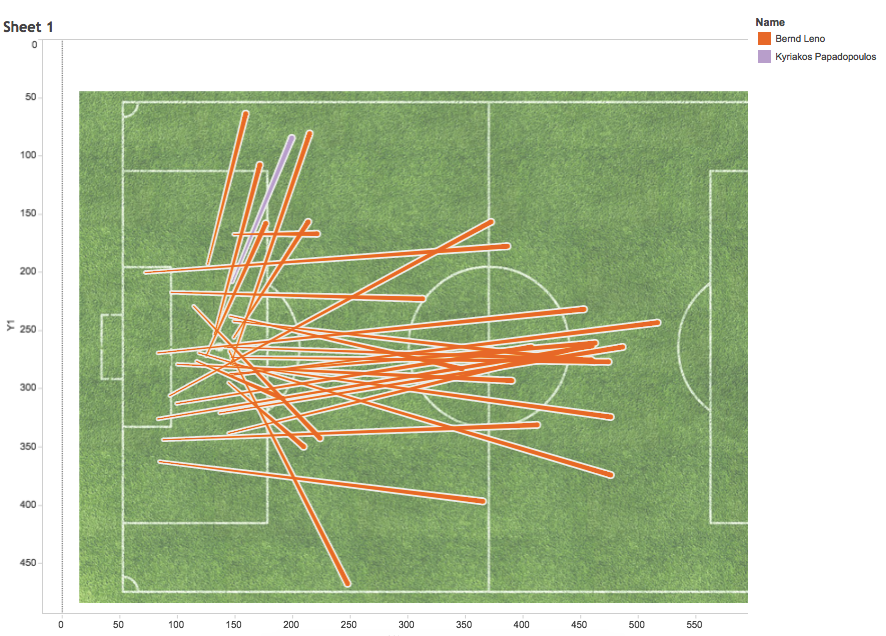
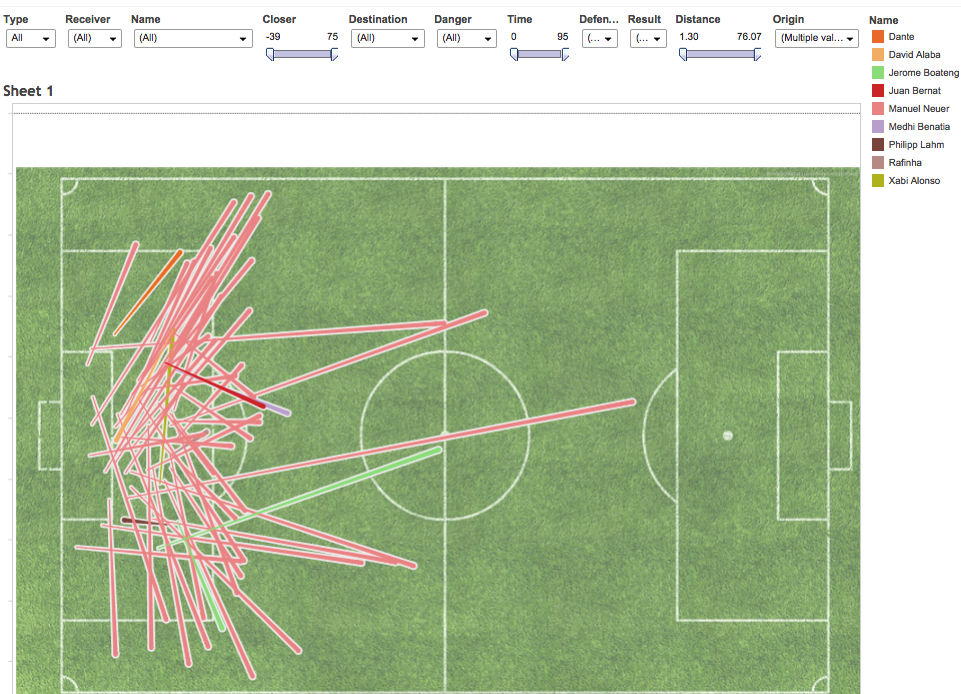 or if you want to compare all passes of under 6 yards by both teams you can:
or if you want to compare all passes of under 6 yards by both teams you can: 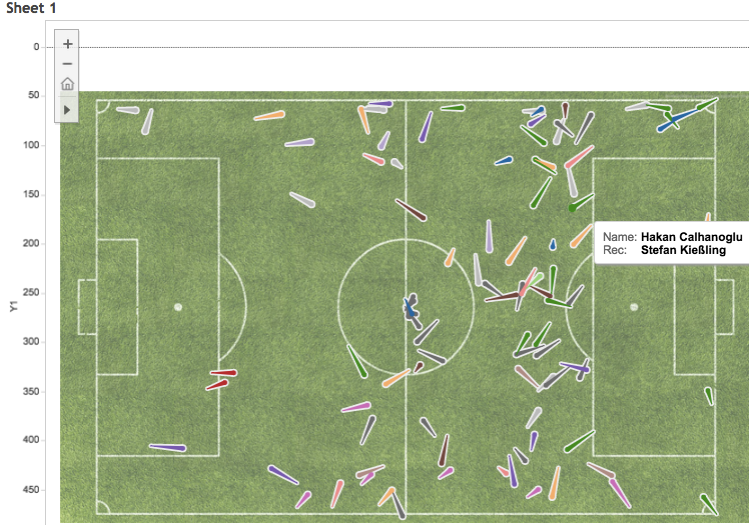
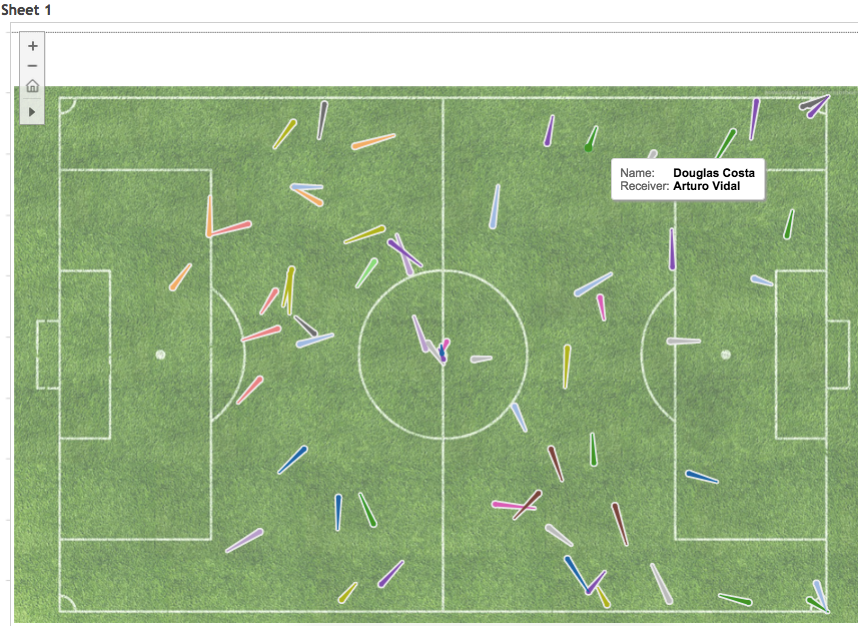 or if you want to see all 2nd half completions made by either Xabi Alonso or Vidal and received by either Lewandowski or Muller that moved Bayern 9+ yards closer to goal, you can do that:
or if you want to see all 2nd half completions made by either Xabi Alonso or Vidal and received by either Lewandowski or Muller that moved Bayern 9+ yards closer to goal, you can do that: 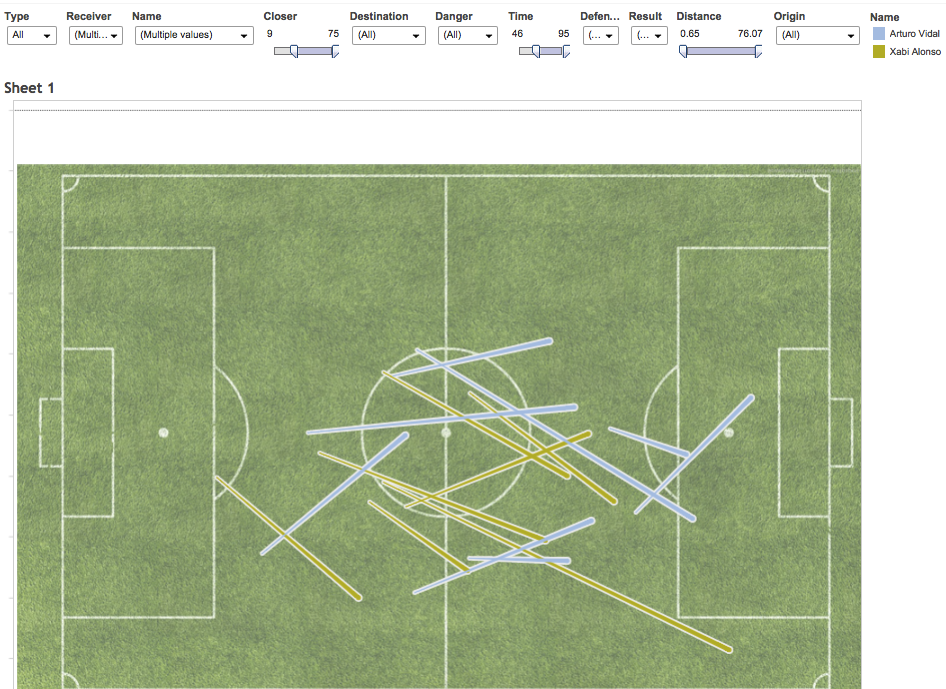 Or if you want to see Leverkusen's passing from centrally in their own half while winning vs trailing, you can. Unsurprisingly, they are much more aggressive when behind.
Or if you want to see Leverkusen's passing from centrally in their own half while winning vs trailing, you can. Unsurprisingly, they are much more aggressive when behind. 
 The point is, whatever you want to see, just mess with the filters and you can hopefully find it. This kind of thing helps spark ideas for me and simplifies what can be hard to follow at times on the pitch. Like I didn't realize how stark the difference was in how the two teams play out of the back and the differences in where those really short passes are pretty interesting to me, it seems to show Leverkusen stagnating a bit while Bayern keep spaced as they close in on goal. Hopefully you find something similar that interests you. I waffled back and forth between the coloring scheme, right now it's set at color=result of pass instead of reflecting who passed the ball.
The point is, whatever you want to see, just mess with the filters and you can hopefully find it. This kind of thing helps spark ideas for me and simplifies what can be hard to follow at times on the pitch. Like I didn't realize how stark the difference was in how the two teams play out of the back and the differences in where those really short passes are pretty interesting to me, it seems to show Leverkusen stagnating a bit while Bayern keep spaced as they close in on goal. Hopefully you find something similar that interests you. I waffled back and forth between the coloring scheme, right now it's set at color=result of pass instead of reflecting who passed the ball.  Nothing but Germany this week, sorry I won't neglect the other leagues the entire year but this was a busy piece. Hope you enjoy, comment below or on twitter @SaturdayOnCouch.
Nothing but Germany this week, sorry I won't neglect the other leagues the entire year but this was a busy piece. Hope you enjoy, comment below or on twitter @SaturdayOnCouch.
